#12 anthologies and collections
Text
dead boy detectives reading list
with the show finally out i figured it was a great time to share my reading list again! check it out below the cut 👻☠️🔎
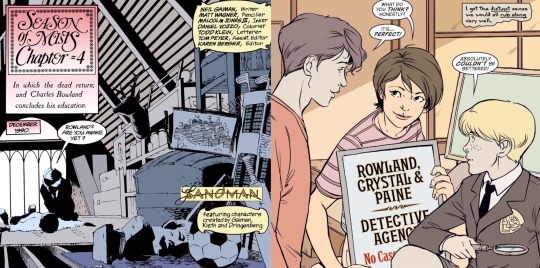
-

⏳ the sandman #25 (1991)
this is their first appearance!
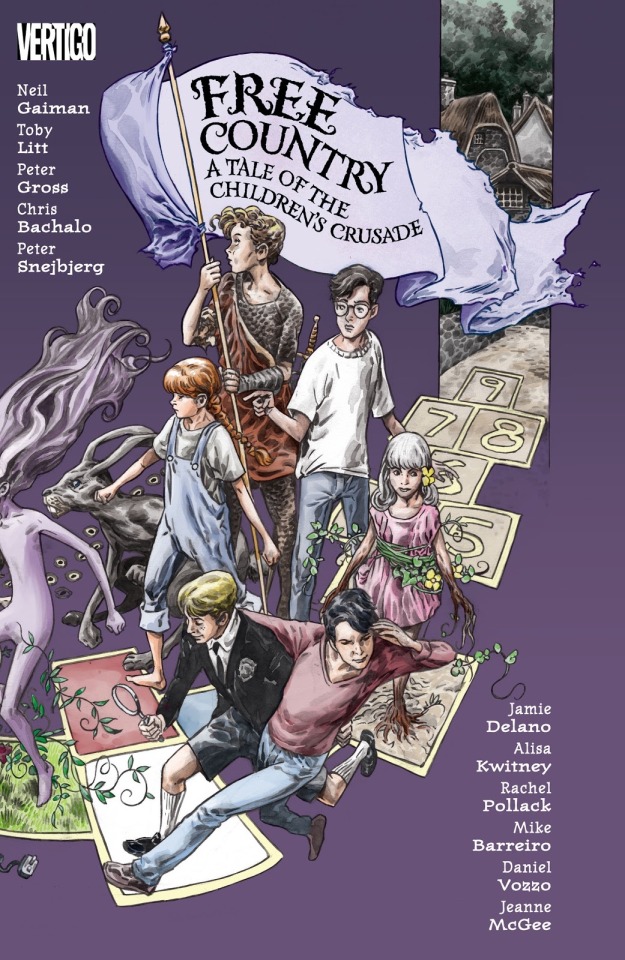
🐇 the children's crusade (1993)/free country: a tale of the children's crusade (2015)
1. the children's crusade #1
(2. black orchid annual #1
4. animal man annual #1
5. swamp thing annual #7
6. doom patrol annual #2
7. arcana annual #1)
8. the children's crusade #2
alternatively you can just read free country. whether or not you read the annuals i recommend reading free country's middle chapter
!!! in place of the annuals there is an additional middle chapter that was created for the book "free country: a tale of the children's crusade" where it is placed between the two children's crusade issues. the boys don't actually appear in most of the annuals (they are in two panels of swamp thing and appear in doom patrol) and reading them isn't necessary but i figured i would include them as they are part of the story.
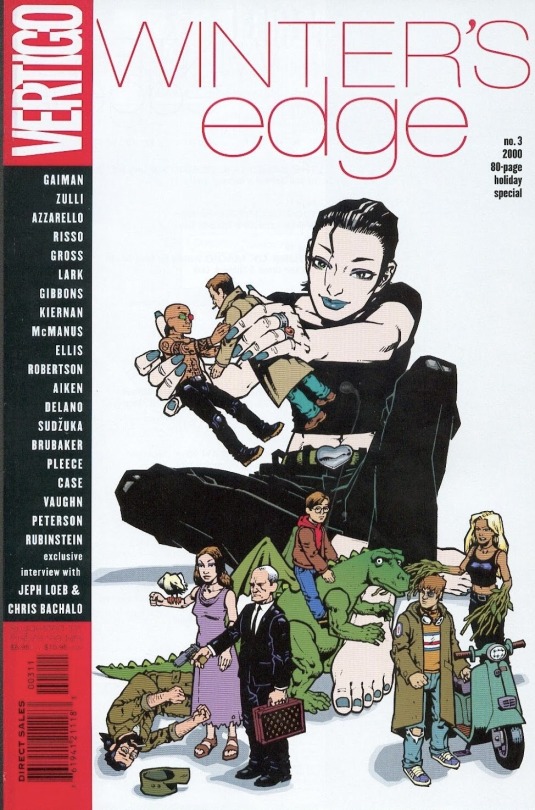
❄️ winter's edge #3 (2000)
this is an anthology. their part is the 'books of magic: waiting for good dough' story starting on page 19

🐦⬛ the sandman presents: the dead boy detectives (2001, 4 issues)
i believe the tv show's esther finch was partially based on this run's villain.
*
(they do have a part in 'death: at death's door' from 2003. it's short and really just a retelling of events from sandman #25 with some minor changes. the entirety of their appearance in death: at death's door is included at the end of the next comic im listing so i am not really adding the death: at death's door book to the list)
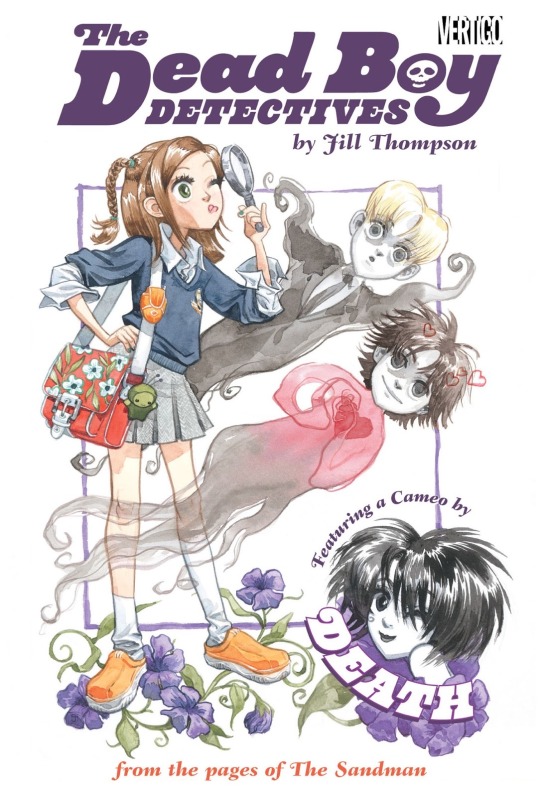
☠️ the dead boy detectives (2005, one-shot)
this book was made by jill thompson in a very cute manga-esque style

👻 ghosts (2012), time warp (2013), the witching hour (2013)
these three are anthologies. the story 'the dead boy detectives in: run ragged' runs through all of them. 'run ragged' kicks off the next run.

🔮 from the pages of the sandman: dead boy detectives (2013, 12 issues)
this is the comic where crystal is introduced! a book collecting all 12 issues titled 'dead boy detectives by toby litt & mark buckingham' was released in 2023
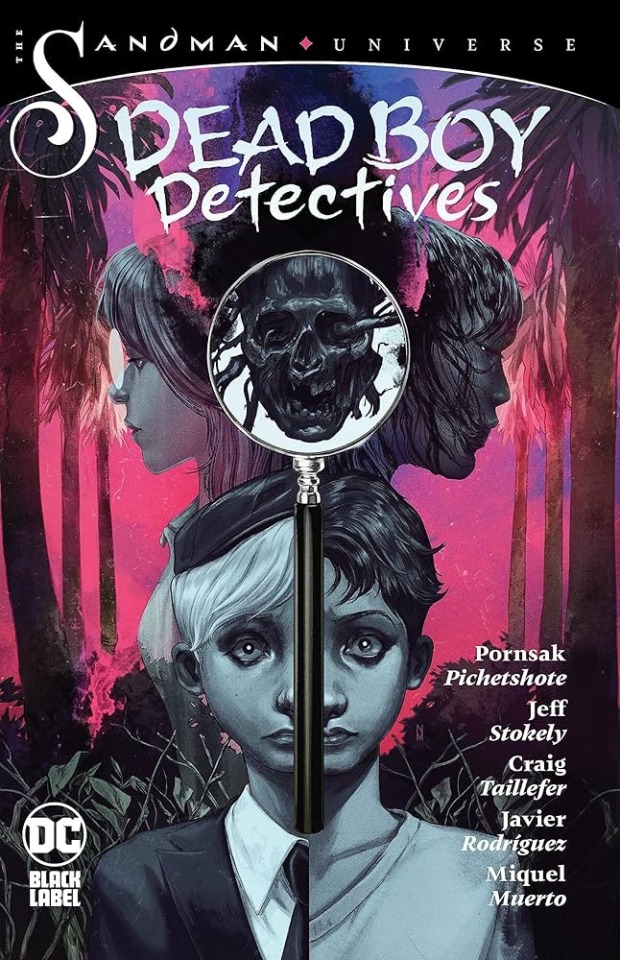
🔎the sandman universe: dead boy detectives (2022, 6 issues)
the most recent run, centered around some really interesting thai mythology and featuring multiple edwin moments that i am sure you will love
-
and that's everything! i also recommend buying the omnibus if you can. it includes everything minus the 2022 run plus some additional bonus content!

i hope this is helpful! feel free to ask me any questions you may have about the comics. dead boy detectives is my number one interest so i should be able to answer
have fun reading! 👻
#dead boy detectives#the sandman#the sandman universe#comics#reading list#edwin paine#edwin payne#charles rowland#crystal palace#crystal palace surname von hovercraft#painland#paynland#i really hope i didnt mess up while making this post fjdkfkjdkf
919 notes
·
View notes
Text
Dear Murray,
I have been unable to reply any sooner to your last letter which reached me quite some time ago. [8] I have read it twenty times. [3] There is too much irony in it, it is too knowing to be serious. [5] There is still much I don't even begin to understand, but for seven days, the bits have been clumping together into a vague picture. [7] I don't see how this could work [9]. I don't like it.[7]
Your plan contains a central tower a central observation post [10],giving you a stage to ‘talk’, with not only Venetian blinds on the windows of the central observation hall, but, on the inside, partitions that intersected the hall at right angles and, in order to pass from one quarter to the other, not doors but zig zag openings; for the slightest noise, a gleam of light, a brightness in a half opened door would betray the presence of the comedian, you[11] I wonder will you allow us totalk. [13] With you every statement is converted to a rhetorical question. [5] Always talking, never giving, staying in a good position in irreversible logic. [12] This device, by itself, politicises talking,[5] it automatizes and disindividualizes power [11]
What goals are such systems designed to achieve?[14] It’s not just you; nobody, appears to know exactly what anyone else is talking about, the terms of discussion having become either too generic or too divergent to achieve any mutual understanding. [15] People talk about you a bit: forget you. [13] They wonder if they should talk any, or talk the whole time, or what to talk about.[16]Our mind cannot embrace many objects or many situations at the same time. [17] What if there is no word, real or fabricated, which will accomplish that? [18] What will you do then?
I'm afraid I don't quite understand what all this talk of “issues" is about. [18] We know how greatly laws are disregarded during war, when all things are under the control of violence rather than reason [19] War and chaos there might have been, but these were hardly new phenomena in the recent history. [20] The body, the statue, our knowledges or memories, libraries or cenotaphs: all imprison the phantom by denying its existence. [21] lt is far easier for us to imagine chaos than the proper proportions of the universe. [17] Talking ,in this case, is just pointless. Words to put you to sleep, wine to put you to sleep, words and wine to put the tragic and comic of existence to sleep.No bread for the poor, no love for the men, no wine for the feasts, nothing, always nothing, wind, nothing but wind. [ 22]
In your letter you say: I executed this project slowly, and at different times, but with as much application and care as I was capable of employing, being fully persuaded that the repose of my life and future happiness depended on it. [3]
So I would like to know if you have any clarifications on this point, because this is what I'm thinking: [23]Happiness without glass how stupid is that![24]
I believe that the mystery which defeats me is a mockery, a joke, that is played on me.[25] Verily, you comedians are the most pleasant people in point of tongue and the subtlest in jest, and this is but a joke of thine; but all times are not good for funning and jesting.[26]
You’re such fun, always joking, you’re so clever at it, nothing that you thought was serious ever seems to be when you’re around, and yet you're a very serious man. [27] However, it remains questionable whether you, for your part, can really be serious about the antithesis to it: "to mean it seriously.” [28]
Just a little heart to heart talk.[13]This friend, in whose company you are jesting, is in fear. [29]I see your peace of mind is in danger…For a condemned man, a mask is not a mask, it is a shelter. [2] It’s an obsession with you, it isn’t natural that you should always be talking about it. [30]
I know, you won’t listen. I know you’ll do exactly as you please and write it off as a joke. If you’re going to talk, then talk so we can hear you! Talk about centralisation! [25] Talk about superfluous overpackaging! [30]Talk of mysteries! [32] Talk about an irresistible offer! [16]Talk about apple dumplings, piuttosto. All a kind of attempt to talk. Talk: as if that would mend matters. [13] But don’t you dare make me a part of it!
Istanbul
#1 Aquinas;Summa Theologica#2 Hugo; Les Miserables#3 Rousseau;Collected Works of Jean-Jacques Rousseau#4 Eliade; The Sacred and The Profane#5 Carter; Shaking A Leg#6 Abulafia; The Boundless Sea#7 Asimov;Complete Robot Anthology#8 Spinoza; Complete Works#9 Delanda Harman;The Rise of Realism#10 Giedion; Space Time and Architecture#11Foucault; Discipline and Punish#12 Serres;The Parasite#13 Joyce; Ulysses#14 Russell Norvig; Artificial Intelligence#15 Costelloe; The Sublime#16 Hovestadt Buehlmann; Quantum City#17 Harrison Wood Gaiger; Art in Theory 1648 1815#18 Hofstadter; Godel Escher Bach#19 Calvin; Harmony of the Law Vol 2#20 Burke; Rethinking the High Renaissance#21 Serres; The Five Senses#22 Serres; The Parasite#23 Deleuze; Desert Islands and Other Texts#24 Leatherbarrow Eisenschmidt; Twentieth Century Architecture#25 Marx; Collected Works#26 The Book of the Thousand and One Nights#27 Rand; The Fountainhead#28 Sloterdijk; Critique of Cynical Reason#29 Seneca; Complete Works#30 Proust; In Search of Lost Time Vol V The Captive The Fugitive
0 notes
Photo

When I Was Me Comic
My one page comic for the "When I Was Me" anthology;
a collection of autobiographical comics about the joyful and euphoric experiences of being transgender, featuring stories from trans people with a wide range of gender identities, ages, and backgrounds! 100% of the team working on When I Was Me fits under the trans umbrella, from pre-press to artists. With 12 interior illustrations and over 60 comics, this book is a wonderful reminder that the trans experience is full of beauty and happiness.
Edited by Eve Greenwood and Alex Assan. Cover art by C. A. P. Ward. Book design by Spire Eaton.
My comic in this book, for the family section, is about a moment I had with one of my niblings at the cottage. The kids in my life are getting a good grasp on what I am and what trans people are, and I am so happy to be that gateway for them.
1K notes
·
View notes
Text
A guide for reading The Sandman: Part 2
So... You have read the full Sandman series. You went from issue 1 to issue 75. From beginning to end. You had all the ten volumes. Congrats!
But I am sorry to tell you, you don’t actually have the full Sandman story. You see, Neil Gaiman wrote and created much more than just the numbered issues. He created a lot of side-stories, side volumes and “specials” whose presence are either exciting and thrilling additions to the Sandman mythos, or key elements needed to understand the plots and happenings of the main story. Don’t get me wrong, if you just read the numbered issues you’ll get the full story without problem. But you’ll still be missing the second part of the complete Sandman world. The “specials”. In French we have a clever word for that: the “hors-séries” (literally means “outside of the series”, it is still part of the world but not inside the numbered series).
Given there is a lot of those specials, I’ll classify them by “publishing order”. You’ll get what I mean.
I) The Sandman library
After being released as a series of numbered issues, The Sandman was collected in the ten volumes I described previously. Out of these volumes, one included actually more than just the numbered issues: volume 6, “Fables and Reflections”, added two Sandman specials.
# “Fear of Falling” was originally a story published as its own for a one-shot issue called “Vertigo Preview” whose function, as the name indicates, was to serve as a big preview for most of the Vertigo titles. As a result, the issue contains previews and half-stories for most of the Vertigo titles: Hellblazer, Doom Patrol, Swamp Thing, Shade the Changing Man... It also includes previews for two specials I will talk about later, Death: The High Cost of Living, and Sandman Mystery Theater. But these are all just previews. There is only one full, complete story, which is precisely “Fear of Falling”, conceived originally as a way to give a taste of Sandman to newcomers.
# The Song of Orpheus. Originally it was published as its own as “The Sandman Special”, but it was included into this first collection of Sandman issues due to how important the story is : for you see, it gives the complete backstory of Orpheus, who is an important character in The Sandman. And while just a retelling of the myth, it is still very precious to understand the full impact of the character.
II) The 30th anniversary edition
After publishing those ten volumes, DC celebrated the 30th birthday of The Sandman by reprinting them... WITH FOUR BONUS VOLUMES!!!
# The first added Volume, Volume 11, is called “Endless Nights”. This specific volume was originally published as its own under the name “The Sandman: Endless Nights”. Published in 2003, so long after the end of The Sandman, it is a set of seven stories, each centered around a different Endless sibling, and their whole purpose is just to further expand the world of The Sandman, and flesh out more the other Endlesses by showing stories from THEIR perspectives. It is technically an “anthology volume / expansion volume” that is not needed to understand the full story, but makes a nice addition to better understand the scope of the world and the working of the Endless. It does however contains spoilers for “Brief Lives” and further, so... it is at its right place as “Volume 11″.
# The second added Volume is NOT called Volume 12 as you would expect. It is rather called... Volume ∞. Of its full name: The Sandman: Overture. This volume was originally a six-part limited series created by Neil Gaiman in 2013 (so LONG after the end of The Sandman, and well after Endless Nights). This is the latest and final work by Neil Gaiman in The Sandman world so far, and it was designed as a sort of “grand finale”. Some people will tell you “It is the first work in chronological order so you should begin here”. DO NOT DARE! THESE PEOPLE ARE LYING TO YOU! Beginning here is the WORST idea you can have. If you want to begin The Sandman, you begin at issue 1, like Neil Gaiman himself.
For you see, “Overture” is a dual story, two series of events tied together that happen, one after the end of The Sandman (so after issue 75) and the other before the beginning of the Sandman (so before issue 1). Overture is both the prologue to The Sandman AND its epilogue. Beginning and end, alpha and omega... Hence the ∞ symbol. It is without a doubt the best way to end the series.
# The two other volumes are both unumbered and called “The Sandman: The Dream Hunters”. And they both tell the same story. So why are there two volumes? Because one is an illustrated novel, and the other is a full comic book issue.
Originally, Neil Gaiman published “The Dream Hunters” as a novel/novella in 1999 (so three years after the end of The Sandman, but before the publication of Endless Nights). It was a fictional story he invented, based upon and inspired by Japanese folklore and Japanese fairytales. Illustrated by Yoshitaka Amano, it takes place in The Sandman world, though it is not part of the main plot and you can actually read the story with no prior knowledge of The Sandman. It became so popular that for the 20th anniversary of The Sandman, in 2008-2009, the novel was adapted into a comic book, a four part mini-series that became its own Sandman volume.
Fun fact: when Neil Gaiman published the story, he wrote in it a fake “origin” claiming he was just adaptating a part of Ozaki’s famous “Old Japanese Fairy Tales”. It was a lie, as Neil Gaiman had entirely invented the story, but it fooled a lot of people who sincerely believed it was some sort of secret or missing story from Ozaki’s book. (He notably had to clear up the matter in “Endless Nights”).
III) The Absolute Sandman
Now you probably think: wow... this is a lot. But I got everything, right? NO YOU FOOL! DC, seeing the enormous success of The Sandman, decided to reprint a new edition of the compilation: The Absolute Sandman, even bigger than the 30th Anniversary edition. Not ten or twelve volumes, but rather six (five numbered volumes plus Overture), containing everything I talked about above (The Sandman Special, Endless Nights, Overture, The Dream Hunters...). Plus more specials not yet included in compilations! Resulting in five volumes + The Absolute Sandman: Overture + one special volume called “The Absolute Death”.
# The Vertigo: Winter’s Edge comics. Vertigo’s Winter Edge was a limited series published from 1998 to 2000 celebrating, every winter, the different lines and series of the Vertigo imprint with special stories. It ran for three issues, and each of them has one story created by Neil Gaiman tied with or part of The Sandman universe. One will maybe ring familiar to the viewers of the show: “A Winter’s Tale”, published in the second issue (1999). This story is actually a description of Death’s backstory, answering many questions about her “life” before the events of The Sandman (and also revealing answers to some questions raised in “Endless Nights”, even though it was published AFTER this story). Parts of it were adapted in the first season of The Sandman tv show.
The other two stories of Winter’s Edge are “The Flowers of Romance”, from Winter Edge 1998 and “How They Met Themselves” from Winter Edge 2000. These stories are fascinating because they actually depict Desire as the protagonist and “hero”. You see, as Gaiman points out, Desire plays an antagonistic role in The Sandman merely because Dream is the protagonist. But here he decided, why not show the reverse, the world where Desire is the protagonist, the “nice” side of Desire: the result are those two stories.
[ The Vertigo: Winter’s Edge issues also contain stories belonging to “The Dreaming”, a spin-off of The Sandman, but given Neil Gaiman was not involved in those I’ll keep it for a later post]
# “The Castle”. This story was originally published in “Vertigo Jam”, which is basically quite similar to “Vertigo Preview” and “Vertigo: Winter Edge”, just a one-shot issue that was an anthology of various stories, each taking place in a different series of the Vertigo imprint.
# The Death mini-series. In 1993, the same year as The Dream Hunters, Neil Gaiman wrote a mini-series with Death as the main protagonist. It was called “Death: The High Cost of Living”. This Death-centered story had three years later a “twin mini-series”: “Death: The Time of Your Life” in 1996 (coupled with the return of Hazel and Foxglove from “A Game of You”). These two were then gathered here as a duo in a special volume of The Absolute Sandman called “The Absolute Death” and centered around, you guessed it, lot of Death material.
# The “educational” Sandman. This “Absolute Death” volume also contains two “PSA material” or “Very Special Episode” issues. One is a story centered around Destruction and called “The Wheel”, which was originally part of a very special DC volume: 9-11: The world’s finest comic book writers and artists tell stories to remember. You can safely guess what the story is about. The second story is not actually a story, but a Death-centered AIDs pamphlet called “Death Talks About Life”. It had been originally coupled with several other issues of DC comics: it was found in the issue 32 of “Shade the Changing Man” (the 1990 series) ; it was also found in the 62nd issue of Hellblazer, and finally in the 46th issue of The Sandman. But it also existed as its own, unique pamphlet distributed in schools to raise awareness of HIV and AIDS.
# Sandman Midnight Theater. The last of the specials created by Neil Gaiman, and one of the last pieces to The Sandman puzzle. Long story short... There were several “Sandman” super-heroes in the DC Universe. In fact, Neil Gaiman began “The Sandman” as his own personal take on the several Sandmen super-heroes of the DC world. The very first of those Sandmen was Wesley Dodds, a Batman-like vigilante of the 30s that was part of the Golden Age of comics. In fact, Wesley Dodds himself appears in the first issue of Neil Gaiman’s The Sandman, and is part of The Sandman universe. After the end of Neil Gaiman’s series, the popularity of Wesley Dodds increased again and so in 1993 was launched a “reboot” of the original adventures of the Sandman, a new series around Dodds called “Sandman Mystery Theater”.
Sandman Midnight Theater is precisely a crossover issue between Sandman Mystery Theater and Neil Gaiman’s The Sandman.
# “The Last Sandman Story”. This is actually not a comic book story. It was a prose story, semi-autobiographical, written by Neil Gaiman for “Dustcovers: The Collected Sandman Covers”, which as the name says compiled all of the covers of Dave McKean (plus I think he also illustrated this specific story?). It a sort of confession story, a text by Neil Gaiman about real-life and his relationship with The Sandman series and the character of Dream. And, as the name says, it was written to be released at the conclusion of the main series, post-issue 75.
There you go! These are all the specials created by Neil Gaiman and that are part of the canon and official Sandman series. Of course there is more bonus to talk about: Neil Gaiman gave a lot of interviews about The Sandman in which he reveals all sorts of details and secrets, and they can be found across various books - the Sandman Companion, the Absolute Sandman editions, the Omnibus Sandman editions, there’s plenty of places to look at.
So... is it done? Is it over?
Yes and no. With this, you have covered everything in The Sandman world made by Neil Gaiman. So this is basically all the “canon”.
But The Sandman created a lot of spin-offs and side-stories that were not created or that are not linked to Neil Gaiman... as with many comic book worlds, it expanded beyond its original creator. So maybe I will cover all the non-Neil Gaiman Sandman stories in a third part. Maybe. If I have time.
#sandman#the sandman#comic books#comic book#comics#reading guide#neil gaiman#specials#dream of the endless#death of the endless#desire of the endless#destruction of the endless
5K notes
·
View notes
Text
“Aim For The Heart” Cover Reveal!

We are only SIX DAYS out from our next Kickstarter, launching on June 15th, 2023, so what better time than now for a cover reveal!!
AIM FOR THE HEART: QUEER FANWORKS INSPIRED BY ALEXANDRE DUMAS’S THE THREE MUSKETEERS is an all-new anthology of queer works of fiction and art, including 20 stories, 19 full-page grayscale art works, and a 12 page comic! This gorgeous collection is printed A4 size – 8.25 in. by 11.75 in, or 21 cm x 30 cm. It is absolutely full of all the melodrama, laughs, and feels of the source material – just much, much queerer!
We are SO EXCITED to finally share our spectacular cover with you, featuring the gorgeous work of the incomparable Pallas Perilous (Tumblr | Twitter).
You’ll be able to get this book for as little as $15, and higher-level packages include the book in print, a bookmark, an enamel key chain, a magnet of the cover art, and our newest dux sticker! We’re also offering scads of add-ons, including an exclusive opportunity to get some of the few remaining print copies of our first Queer Fanworks Inspired By… anthology, And Seek (Not) to Alter Me: Queer Fanworks Inspired by Shakespeare’s “Much Ado About Nothing.” You can learn more about the backer levels, merch, pricing, and add-ons by reading our FAQ.
Make sure you don’t miss your chance to back this awesome collaborative project! FOLLOW OUR KICKSTARTER PAGE NOW!
And – people who support us on Patreon and back the crowdfunding campaign will get an EXCLUSIVE EXTRA MAGNET! So if you love what we do, this is a great time to become a monthly backer!
Who We Are: Duck Prints Press LLC is an independent publisher based in New York State. We help fancreators publish their original (mostly queer) work! Want to always hear the latest? Sign up for our monthly newsletter!
427 notes
·
View notes
Text
what's up ! non-exhaustive list of stories featuring weird plants :
The Day of the Triffids, John Wyndham
The Night of the Triffids, Simon Clark
In the Tall Grass, Stephen King and Joe Hill
The Boats of the 'Glen Carrig', William Hope Hodgson
The Man Whom the Trees Loved, Algernon Blackwood
The Red Tree, Caitlín R. Kiernan
Annihilation, Jeff VanderMeer
The Willows, Algernon Blackwood
The Nature of Balance, Tim Lebbon
'Bloom', John Langan
The Ruins, Scott Smith
The Wise Friend, Ramsey Campbell
'The Green Man of Freetown', The Envious Nothing : A Collection of Literary Ruins, Curtis M. Lawson
The Beauty, Aliya Whiteley
The Ash-Tree, M.R. James
Canavan's Backyard, J.P. Brennan
Invasion of the Body Snatchers, Jack Finney
The Hollow Places, T. Kingfisher
'Reaching for Ruins', Crow Shine, Alan Baxter
'Vortex of Horror', Gaylord Sabatini
Hothouse, Brian W. Aldiss
Vaster than Empires and More Slow, Ursula K. Le Guin
Odd Attachment, Ian M. Banks
Deathworld #1, Harry Harrison
The Bridge, John Skipp and Craig Spector
'The Garden of Paris', Eric Williams
Apartment Building E, Malachi King
The Seed from the Sepulchre, Clark Ashton Smith
Rappaccini's Daughter, Nathaniel Hawthorne
The Nursery, Lewis Mallory
The Other Side of the Mountain, Michel Bernanos
The Vegetarian, Han Kang
Sisyphean, Dempow Torishima
The Root Witch, Debra Castaneda
Semiosis, Sue Burke
The Wolf in Winter, Charlie Parker #12, John Connolly
Perennials, Bryce Gibson
Relic, Douglas Preston and Lincoln Child
Gwen, in Green, Hugh Zachary
The Voice in the Night, William Hope Hodgson
Ordinary Horror, David Searcy
The Family Tree, Sheri S. Tepper
The Book of Koli, Rampart Trilogy #1, M.R. Carey
Seeders, A.J. Colucci
Concrete Jungle, Brett McBean
The Plant, Stephen King
Anthologies/collections :
The Roots of Evil: Weird Stories of Supernatural Plants, edited by Michel Parry
Chlorophobia: An Eco-Horror Anthology, edited by A.R. Ward
Roots of Evil: Beyond the Secret Life of Plants, edited by Carlos Cassaba
The Green Man: Tales from the Mythic Forest, edited by Ellen Datlow and Terri Windling
Sylvan Dread: Tales of Pastoral Darkness, Richard Gavin
Evil Roots: Killer Tales of the Botanical Gothic, edited by Daisy Butcher
Weird Woods: Tales From the Haunted Forests of Britain, edited by John Miller
'But fungi aren't plants' :
The Fungus, Harry Adam Knight
Growing Things and Other Stories, Paul Tremblay
The Girl with All the Gifts, M.R. Carey
Mexican Gothic, Silvia Moreno-Garcia
Fruiting Bodies, and Other Fungi, Brian Lumley
'The Black Mould', The Age of Decayed Futurity, Mark Samuels
What Moves the Dead, T. Kingfisher
The House Without a Summer, DeAnna Knippling
Mungwort, James Noll
Fungi, edited by Orrin Grey and Silvia Moreno-Garcia
Trouble with Lichen, John Wyndham
Notes :
all links lead to the goodreads page of the book, mostly because i like to look at book cover art ;
list features authors/books that i love (T. Kingfisher, Silvia Moreno-Garcia, Ursula K. Le Guin, the collections from the British Library Tales of the Weird, etc.), but also a few that i don't like and some that i have not yet read ;
if upon seeing that list the first novel you check out is by Stephen King's you have not understood the assignment ;
not all of those are strictly horror stories, some are 100% science fiction (Brian W. Aldiss' Hothouse for instance).
#text#ramblings#plant tag#botanical horror#last time i posted a list of non-fiction books on the topic. time for some variety
156 notes
·
View notes
Text
Audio Drama Recommendations, Pt. II

For part one, click here. I went on another audio drama binge and I found some that were pretty fun to listen to. I usually tend to go after the ones that are completed because the longer the wait, the more likely I will forget the details, but this time I just went for anything that caught my attention. This also isn’t in any particular order.
The Magnus Archives – is a horror fiction anthology podcast written by Jonathan Sims, directed by Alexander J. Newall, and distributed by Rusty Quill.
The new Head Archivist of the Magnus Institute, Jonathan Sims, attempts to bring a seemingly neglected collection of people’s testimonials of their encounters with the supernatural up to date, converting them to audio and supplementing them with follow-up work from his small but dedicated team. [COMPLETED]
It has five seasons, each 40 episodes long, as well as additional content such as Q&As, non-canon fan-submitted statements and one-off episodes that tie in with Rusty Quill's other podcasts.
It does start out slow and maybe at some point you’ll be wondering where is this going and what does some of these episodes have to do with the overall story, but it does all eventually connect. Your patience will pay off because once the build-up is done it picks up and things get really interesting!
Unwell – is a horror podcast starring Clarisa Cherie Rios and produced by Hartlife NFP.
The story follows Lillian Harper who has returned home to Mt. Absalom, Ohio to care for her estranged mother Dorothy after an injury. Living in the town's boarding house which has been run by her family for generations, she discovers conspiracies, ghosts, and a new family in the house's strange assortment of residents. [ONGOING]
This audio drama has five seasons which runs for 12 episodes. It currently has 54 episodes in total and each one is about 20-30 minutes long. New episodes are released fortnightly (biweekly) on Wednesdays. They take a mid-season break between episodes 6 and 7.
Bridgewater – is a supernatural thriller audio drama produced by Grim & Mild and by iHeartRadio, created by Aaron Mahnke and written/directed by Lauren Shippen.
Folklore professor Jeremy Bradshaw is pulled into the mysterious 1980 disappearance of his police officer father, Thomas, by new evidence that threatens to upend decades of certainty. Along the way, he’s helped by some unlikely partners who challenge everything he believes in, and ultimately tries to answer the question: can the past actually be rewritten?
Together with his father’s former partner, retired Detective Anne Becker, Jeremy must chase the clues that will tell him whether his father really did fall victim to a Satanic cult in the Bridgewater Triangle—or something much more dark and unexplainable. [ONGOING]
It has two seasons, the first consist of 10 episodes and the second has 12 episodes. Each one runs about 20-30 minutes long. Season three was put on hold when there was news of a possible television series. However, that fell through and by then everyone was working on other projects. So a season three, well, that’s pretty much up in the air.
It stars Misha Collins (Supernatural), Melissa Ponzio (Teen Wolf), Nathan Fillion (Firefly, The Rookie), Karan Soni (Deadpool), Kristin Bauer (True Blood), Hilarie Burton Morgan (The Walking Dead, One Tree Hill), Wil Wheaton (Star Trek: The Next Generation), Jonathan Joss (The Magnificent Seven, Parks and Rec) and Lori Alan (Spongebob Squarepants, Family Guy).
The Lovecraft Investigations -- is a mystery thriller/horror fiction podcast written and directed by Julian Simpson, based on several works of H.P. Lovecraft. It’s produced by Sweet Talk Productions for BBC Radio 4. It concluded with three seasons and each episode is about 25-30 minutes long. There might be a fourth season in the works, but even if there isn’t the series is considered to be finished.
The first season starts off with an investigation into the disappearance of a young man, Charles Dexter Ward from a locked room in an asylum. [COMPLETED]
It stars Barnaby Kay (Shakespeare in Love), Jana Carpenter (Doctor Who), Nicola Walker (MI-5, Unforgotten), Mark Bazeley (The Queen, The Bourne Ultimatum), Phoebe Fox (Eye in the Sky, The Woman in Black 2: Angel of Death), Steven Mackintosh (Rang De Basanti, Lock, Stock and Two Smoking Barrels), Samuel Barnett (Dirk Gently's Holistic Detective Agency, Penny Dreadful), Alun Armstrong (Sleepy Hollow, The Mummy Returns), Adam Godley (The Great, The Umbrella Academy), and so on.
Midnight Burger – is a monthly sci-fi audio drama about a diner at the end – and somehow the beginning – of the universe.
When Gloria took a waitressing job at Midnight Burger outside of Phoenix, she didn’t realize she was now an employee of a time-traveling, dimension-spanning diner. Every day Midnight Burger appears somewhere new in the cosmos along with its staff: a galactic drifter, a rogue theoretical physicist, a sentient old-timey radio, and some guy named Caspar.
No one knows who built Midnight Burger or how it works, but when it appears there's always someone around who could really use a cup of coffee. Come by any time, we open at six. [ONGOING]
The audio drama currently has three seasons and each episodes averages about 30 minutes to an hour or so.
Rex Rivetter: Private Eye – is a 1950s-style noir detective audio drama written by Greg McAfee, directed by Rhiannon McAfee, and produced in San Diego, CA by Downstairs Entertainment with editing and sound design by Steve Murdock. The Rex Rivetter theme “Nightmare” by the Artie Shaw Orchestra is used with permission of Music Sales Corp.
The year is 1955. Tinsel town. The land of make-believe. It's a time of growth in American prosperity. Especially in Los Angeles. Here, dreams are bought and sold.
But there's a seedier side to the City of Angels, the shadows where pimps and narcotics pushers live, where organized crime stands just around every corner with one hand out, and the other wrapped around a roscoe. It's a city full of fancy dames and slick cons, where bookies know the vig, so you better, too.
Some folks call it noir or pulp fiction. But for a private eye named Rex Rivetter, it's home. [ONGOING]
It has four seasons and each one runs about 20-30 minutes long. Due to the pandemic, it is still unknown if season five will ever come out and so far there hasn’t been any news about it either.
Mansfield Mysteries – is a satirical, cozy murder whodunit written by Amy Henson, directed by Nicholas Hoyt and produced by The QuaranTeam.
It follows the inquisitive, martini-loving socialite Dorinda Mansfield and is set in quiet, affluent Berkshire Bay. So far it only has one season, which contains nine hilarious episodes, each three-chapter story finds Dorinda wrapped up in a new murder. With the help of her devoted daughter, Stacey—as well as the occasional frenemy—Dorinda digs for clues, navigates Berkshire Bay’s elite social circles, and sifts through years’ worth of grudges and motives. In this company town, no one can be trusted, and everyone has something to hide.
Whether at the Labor Day Extravaganza, the Halloween Tennis Club Open, or secret karaoke night, Dorinda sets out to find the real killer before they get away with murder… Just as soon as she orders her martini! [COMPLETED]
If you’re looking for a bite-sized audio drama, this might be for you. It has three seasons (or chapters) and each one only takes three episodes to complete its tales, which is fun, amusing and will keep you entertained while you’re working on something or resting your eyes.
The Call of the Void – is an indie science fiction mystery audio drama created and written by Josie Eli Herman and Michael Alan Herman. It’s produced by Acorn Arts & Entertainment. It contains three seasons of 28 episodes and each one is about 25-30 minutes long with a cast of about 35 actors.
In the bustling streets of New Orleans, a tour guide and a palm-reading outcast team up to unravel the mystery behind cases of sudden insanity besetting the city. [COMPLETED]
Wolf 359 – is a science fiction audio drama created by Gabriel Urbina and produced by Gabriel Urbina and Zach Valenti under Kinda Evil Genius Productions. It consists of four seasons with 61 episodes in total and each one is about 25-40 minutes long.
It is set on board the U.S.S. Hephaestus space station orbiting the star Wolf 359 on a deep space survey mission. The dysfunctional crew deals with daily life-or-death emergencies, while searching for signs of alien life and discovering there might be more to their mission than they thought. [COMPLETED]
#audio#podcasts#audio drama#podcast#listen#audio dramas#the call of the void#wolf 359#mansfield mysteries#midnight burger#the lovecraft investigations#the magnus archives#bridgewater podcast#unwell#unwell podcast#rex rivetter: private eye
141 notes
·
View notes
Text
Cybrsan’s ATEEZ Masterlist
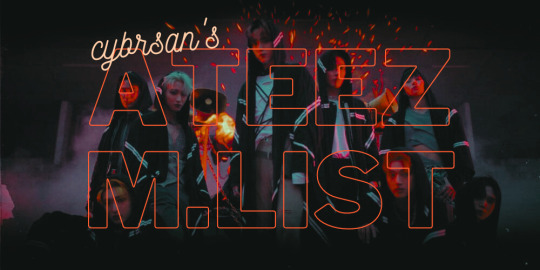

Imagines
ATEEZ as Benders - ATLA Inspired
Series
Ode to ATEEZ: An anthology of standalone stories based on ATEEZ’s title tracks and singles. Each will have a different plot and pairing, ranging from one member x reader to multiple members x reader.
Together in Harmony: A collection of interconnected stories where ATEEZ are all benders. Based on the ATLA universe.

One-Shots
Light It Up! [smut]: The year is 2077, and the world is a lawless dystopia where tech giants and major corporations hold all the power. Kim Hongjoong and Park Seonghwa are an infamous criminal duo who have made names for themselves fighting against the “techno brainwashing” of society. Discovering they’re on the brink of getting caught, they decide to go out with a bang—and who better to help them than their favorite plaything?
Pirate King [smut]: You are playing a dangerous game with an even more dangerous man, and you don’t know how much longer it can go on before everything falls apart around you.
Requests
93. “Say you want me, and I’m yours.” + 123. “Fuck you.” “When?” [angst, fluff, smut]
Tarot
General Reading [July 2023]
Timestamps
12:47 AM [smut]

One-Shots
Light It Up! [smut]: The year is 2077, and the world is a lawless dystopia where tech giants and major corporations hold all the power. Kim Hongjoong and Park Seonghwa are an infamous criminal duo who have made names for themselves fighting against the “techno brainwashing” of society. Discovering they’re on the brink of getting caught, they decide to go out with a bang—and who better to help them than their favorite plaything?
Vignette: Duty [no pairing]: Seonghwa has been working toward one goal for as long as he can remember, which is making his father proud. To do so, he needs to win the Nightingale commendation, be the best of the best. But when he falls a step behind Hongjoong, he has to reconsider what it is he truly wants.
Requests
106. “I’m going to fuck you until you forget that asshole’s name.” + 107. “Bend over the desk, love.” [smut]

Requests
1. “Come over here and make me.” + 14. “You heard me. Take. It. Off.” + 36. “You were put on this earth to give me a headache.” [angst, fluff]
106. "I'm going to fuck you until you forget that asshole's name." [smut]
125. “Here, let me help you.” + 148. “I really want to kiss you right now.” “Then do it.” [fluff]

Tarot
General Reading [Aug 2023]

One-Shots
Party of Three [smut] ft. Wooyoung: Things take an unexpected turn when Wooyoung walks in on you and San.
Roll The Dice [smut]: In the wake of his recent world tour, your boyfriend has decided to treat you to a night out in Las Vegas to commemorate his success and your upcoming anniversary. Though the city is renowned for its gambling, the two of you play a much more interesting game of chance.
Three Hearts as One [angst] ft. Wooyoung: It had been a good day. That should have been the first warning sign that something was about to go horribly wrong. After all, how much peace can you expect in an apocalypse?
Tarot
General Reading [July 2023]

Requests
10. “I’ve seen the way you look at me when you think I don’t notice.” + 67. “Uh, am I interrupting?” [smut]

Imagines
Bouncy!Wooyoung in the Mafia
One-Shots
Party of Three [smut] ft. San: Things take an unexpected turn when Wooyoung walks in on you and San.
Three Hearts as One [angst] ft. San: It had been a good day. That should have been the first warning sign that something was about to go horribly wrong. After all, how much peace can you expect in an apocalypse?
Series
Treasure [angst, fluff, smut]: Wooyoung is moon-blessed, a waterbender born under the Siren Moon that rises once every 88 years. His blessing is believed to be his unique and powerful healing abilities that he has coined “Wavesong.” However, his true gift is that of his prophetic dreams, glimpses of futures yet to unfold—and you just happen to be the subject of his recent visions.
Tarot
General Reading [July 2023]

Requests
25. “It hurts…” “What?” “Loving someone who doesn’t love you…” + 29. “Just because you can doesn’t mean you should.” + 34. “Why are you so cold?” [angst]
#ateez masterlist#ateez fics#ateez imagines#ateez reactions#ateez x reader#hongjoong x reader#seonghwa x reader#yunho x reader#yeosang x reader#choi san x reader#mingi x reader#wooyoung x reader#jongho x reader#hongjoong imagines#choi san imagines#wooyoung imagines#yunho imagines#seonghwa imagines#mingi imagines#yeosang imagines#jongho imagines#mlist
197 notes
·
View notes
Text
My little finding outside the movies - "Krumkake" ❄️
My last (ninth) finding is how many appearances of Krumkake in various books 😄 As Anna mentioned, there are a lot of bakers in Arendelle (from 'All Is Found: A Frozen Anthology - Engaging Anna and Kristoff'), this means lots of cookies, waffles, and pies are mentioned in various books. However, I've noticed that the cookie with the most appearances, which happens to be one of Anna's favorites, is Krumkake💙
Frozen: The Junior Novelization (Pg. 32)

2. A Frozen Heart (Pg. 90)
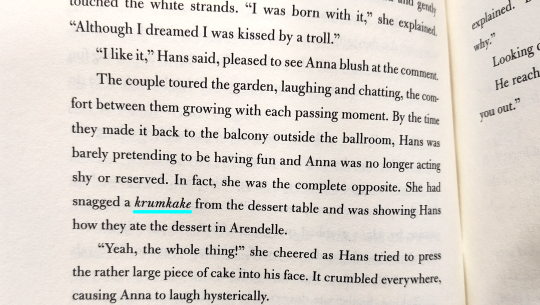
Based on the two books above, I believe that what Hans was eating was Krumkake:
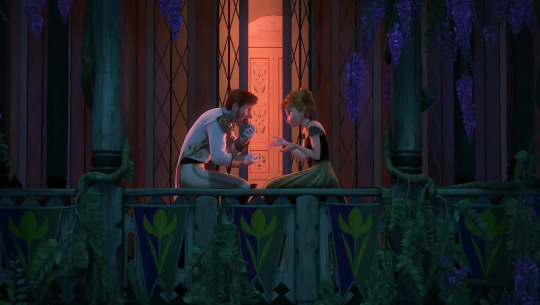
3. Conceal, Don’t Feel (Pg. 16)
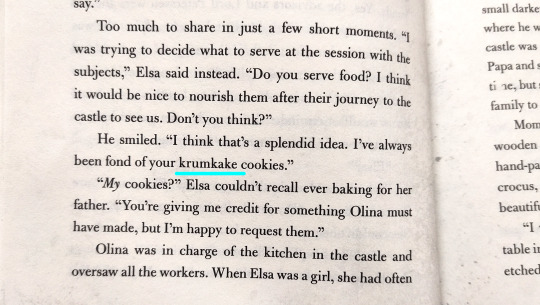
4. Dangerous Secrets: The Story of Iduna and Agnarr (Pg. 166)
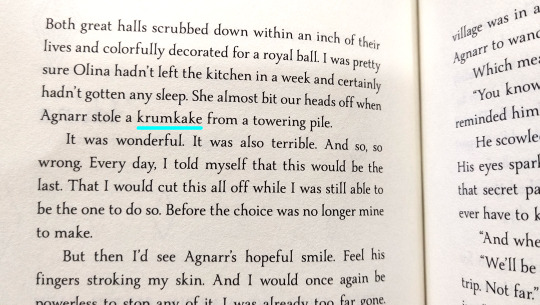
5. "Engaging Anna and Kristoff" in All Is Found: A Frozen Anthology (Pg. 68)

6. "Anna and the King" in All Is Found: A Frozen Anthology (Pg. 186)
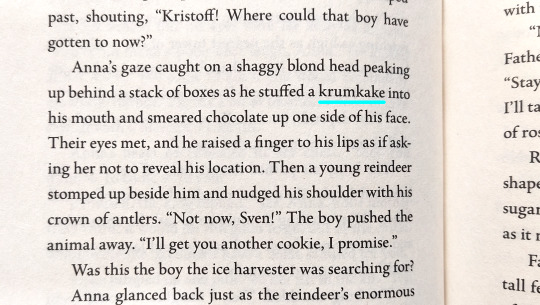
7. "The Next Right Thing" in All Is Found: A Frozen Anthology (Pg. 330)

8. Lost Legend: The Fixer Upper (Pg. 63)
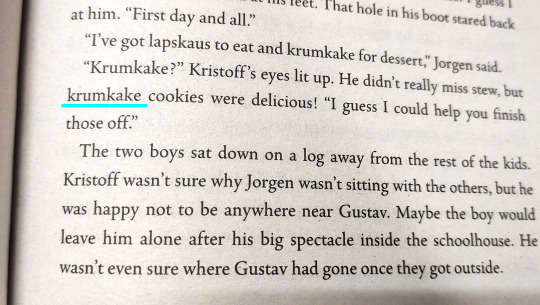
9. "A New Reindeer Friend" in comic Disney Frozen Adventures: Ice and Magic (Pg. 51)
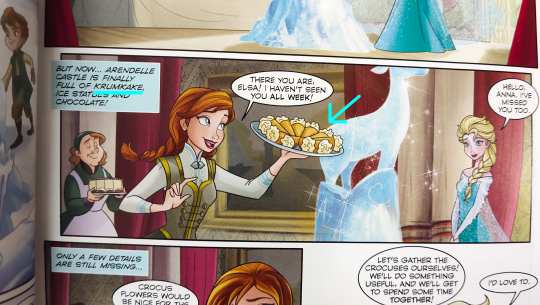
10. Frozen: The Essential Guide (Pg. 9)

11. Unlocking Arendelle: My Treasured Memories, it's interesting to know the Krumkake recipe and how to make it, love this book so much!
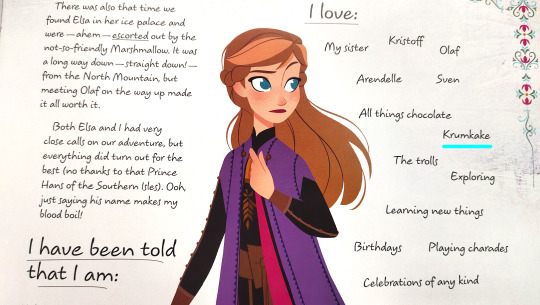

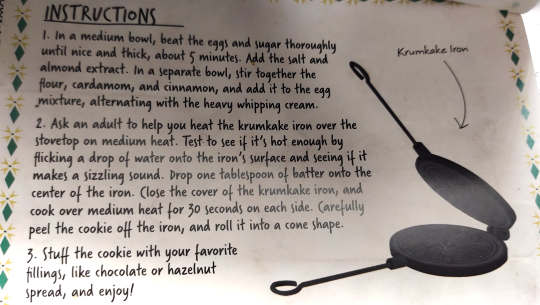
12. "Oaken’s Invention" in Frozen Storybook Collection (Frozen 2 version) (Pg. 62)
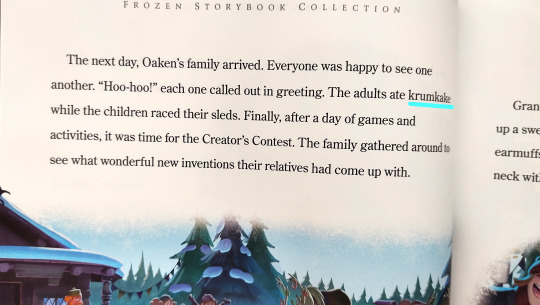
13. Disney Frozen: True Treasure (Pg. 63)
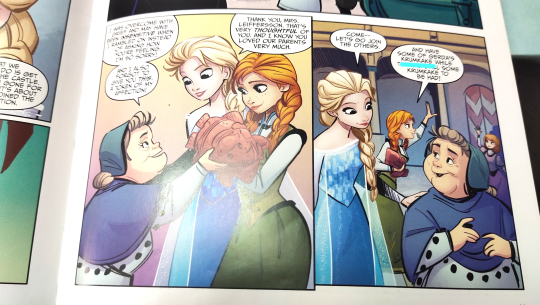
I'm making two little findings in a day 😄 This will be my final finding, it's so enjoyable to uncover the connection between various books. Honestly I can't believe it's been two months since I made the first finding, I would like to thank you to everyone who enjoys my little findings 💙 I haven't finished all the Frozen books, so I'll continue to add more whenever I find new ones (which I believe will be ongoing since there are so many Frozen books😂). I might compile all nine of my findings into a PDF, so stay tuned! 🔥
28 notes
·
View notes
Text

TRIALS OF X Vol. 12 is out now, and marks the final collection in the ‘anthology’ style X collections that began with DAWN OF X and continued with REIGN OF X. 42 Books designed over 4 years.
What a ride!
#design#hellomuller#comics#graphic design#typography#logo#logo design#graphics#branding#logos#x men#x men comics#marvel#wolverine#cyclops#storm#jean grey
127 notes
·
View notes
Text
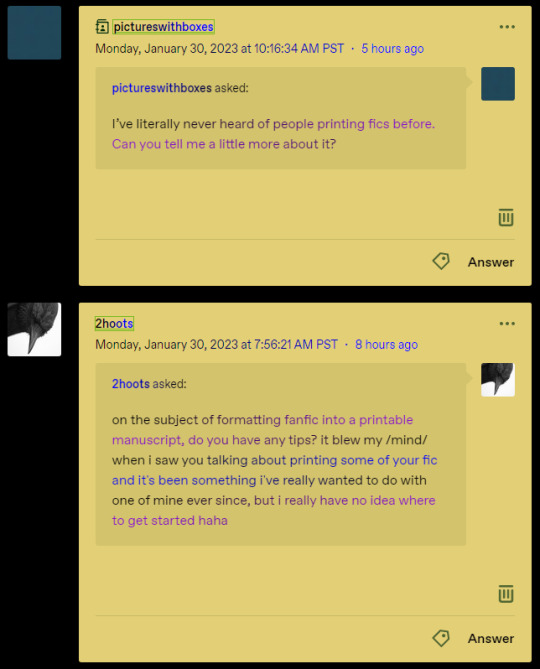
I’d LOVE to talk about it!!!! There is NOTHING like holding a physical copy of a fanfic you love in your hands, whether it is yours or someone else’s. Though I do recommend you get a physical copy of your own work first and foremost, it really cements the fact that you wrote a whole ass novel, or a collection of short stories. The first few fics I ordered were ones I wrote myself and I still go out into my living room to pull them off the bookshelf and just hold them, sometimes.
There are a lot of websites that exist where you can print books without publishing them. The website I use to print fic is Lulu. There are other websites but this one is my fave. Some people have probably written beautiful guides on book binding but I would rather just have a service do it for me. i thought it might be fun to make a whole ass tutorial on my process, if anyone is interested? Because I really think this should be something more people do, I am telling you it'll change your LIFE. Wanna re-read that old fave in your bookmarks? Cut down on screentime! go GRAB IT OFF YOUR SHELF and settle in all cozy :3
SO: HERE IS A WHOLE ASS TUTORIAL ON HOW TO ORDER PRINT BOOKS OF YOUR FAVE FICS.
I use google docs. There are probably ways to do this in other word processing software but google docs is my friend. So this is how I do it. Google is also your best friend when figuring out how to make these adjustments in other word processors fghdg.
So you kinda want to set up the skeleton of your physical fic first. You wanna make a blank document, go to file > page setup and change the paper size to A5. This’ll put it in peak book format! Hurray. You’ll notice things are a bit cramped here but don’t worry, the margins are supposed to be like that. I like single spacing with the typical indent (.50) so thats what I do. I know some people prefer double spacing, so if that’s your jam do it! Just keep in mind it’ll make your book a lot thicker, it really depends on how you want to condense things. Font size is also a factor here. Personally, I LOVE to condense–12 point times new roman font and single spacing is my jam, heres what that looks like:

But again, depending on how long of a story/collection you want to make, you can space things out too.
Make a nice title page! Mine are pretty simple, just the title and the username. Sometimes I’ll put the fandom name like ‘a [fandom] fanfiction’ but for the most part thats just for PDFs i share of my own fic. When it comes to my own fic I also like to put little dedications at the beginning for flair. Again, that’s just for me.

this is from my sicktember anthology, which is just all my sicktember fics in a neat little book. here's Down's:
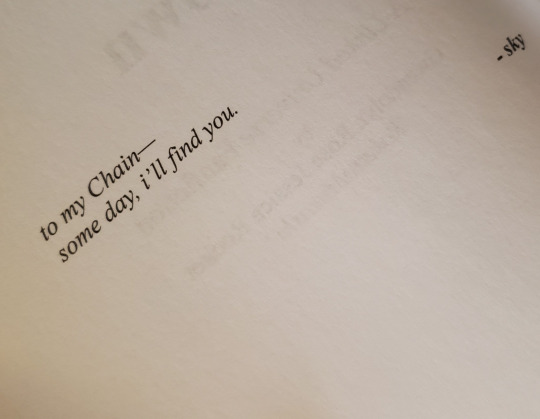
this is my favourite part of printing my own books. i like to get sappy with it.
Add page numbers! This is something you can do automatically in most word processors. You can put em anywhere, I always put mine as footers ‘cause I really just like my fic to feel like a real book. This is under 'insert' in gdocs.
If you’re doing an anthology collection or a lot of fics in one book, a table of contents is good to have! If you apply a heading effect to each story/chapter in google docs, you can automatically insert a table of contents. I usually have to play around with mine a little (and edit it after, pin in that for later) but it’s a good thing to have. But in order to make a table of contents you have to actually have the fic in the doc, so let me teach you how to do that.
Congrats @pictureswithboxes, you are hereby my guinea pig. Because your fic is a good length and it’s the first one that isn’t my own that I’ve turned into a physical copy. Everyone please watch as I turn Turnabout Substitution into a book.
There are many ways and many formats you can download an AO3 fic in. Personally I prefer the HTML format–don’t ask me why, it’s just the best one I’ve seen for keeping things easy to edit and intact. If you work better in PDF or EPUB feel free to download those, but it’s my tutorial so you get HTML.



I drop the HTML file into docs. When you open it, you get this nonsense:
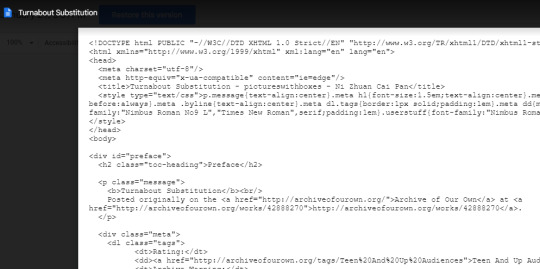
'cause that's a whole ass webpage, obviously. so open it AGAIN, this time using this button up top:
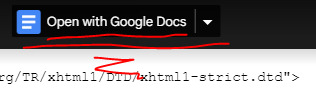
And that gives us… well, a lot more nonsense–it drops all the tags in, authors notes, whatever. You’re welcome to keep author’s notes if you like, personally I do without them (i love to read them digitally! I just keep them out of my physical copies) and everything is in 11 pt times font. The first thing I do is highlight the body of the fic and ONLY the body of the fic. I do this chapter by chapter.
Once I have chapter 1 highlighted, i change the font to my preferred size and typeface–in this case, 12 point times new roman. And then, with the body of the chapter still highlighted, i fix the margins/indent–left to 0, first line to .50, and right to 6.50. Then, with all of that highlighted, I paste it into my ‘book’ doc and all the indents/font choices carry over. Easy peasy.

I go ahead and make a chapter header. I think when doing a proper manuscript a chapter is supposed to start at the mid-point of the page, but i usually have the title at the top and the body text starting halfway down.
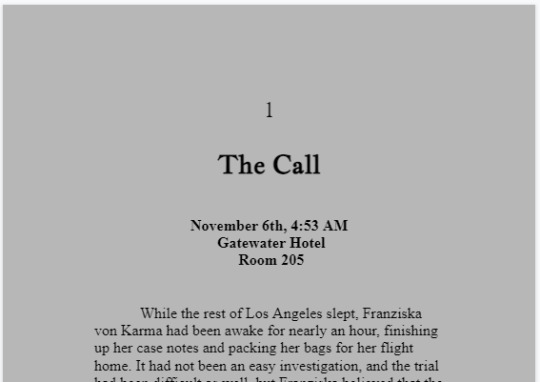
(my doc is in grey to avoid eye strain. if you do this, make sure it's white when you save it xD)
After a chapter–or any time you want to move onto the next section–use a page break! These are under the ‘insert’ tab. They will automatically jump you to the next page, and they will be necessary, for many reasons, but also because!!!
A new chapter should always start on the right page. In order to keep this correct, I take note of if my right pages are evens or odds in page number. Your first page will always be on the right. If you add a table of contents, it should also start on the right–so add a couple page breaks between the two to make a fully blank filler page. In my experience, because page 1 is always right, this usually means your right page will always be an odd number, but for some reason I'm having some weird mandela effect where i swear it wound up evens one time. huh. never hurts to double check! and triple check.
I ignore this all while I’m pasting the chapters in, but then at the end I go through all of them using google docs’ outline feature. Which is honestly NECESSARY for something like this, if you aren't already using it:

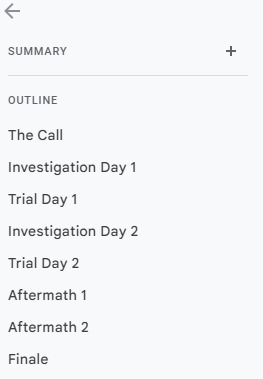
(anything marked as a heading will show up here! or you can highlight something, right click, and add it to outline manually. It's great!)
If my right page is odd-numbered, i check each of them one by one to make sure they all start on odd pages. I add an additional page break in the chapter before if they’re not, to make a filler page. it might feel weird to have all these blank pages in your doc but trust me you will appreciate them when you are actually holding the book.
As I am doing this, I also scroll up to the end of the previous chapters to look for orphans/widows. These are single lines that wind up on their own on the page and look kind of awkward and personally irritate me. Most word processors also have a feature to get rid of these, in google docs you just have to highlight the whole paragraph the line is in (or the paragraph before it, if it’s dialogue or a single line on its own) and apply a heading to it. You can highlight it and click ‘update heading to match’ to do this without changing the font. Good as new! It’ll show up on your outline on the side, but you can delete it by hitting the x beside the lines.
Another thing I do with the body text is i scroll through the whole doc and look for line breaks. AO3 has built-in ones you can insert, and you’re welcome to keep those if they are in a fic you like. Personally i prefer the look of a space to separate, though, so I actually edit them out and replace them with 3 line breaks. Literally just hit the enter key 3 times.
TS here is a case fic, told in the style of the ace attorney vn, which means each chapter has a few locations and timestamps displayed. I do 3 blank line breaks before these, and two after. Because it’s what looks nicest to me. You can play around with aesthetics and see what you like.

Once everything looks good, I scroll back up to update the table of contents if I have it. Google docs has a feature where you can ‘refresh’ it, but… I do not recommend this, because if you formatted your table (which you most likely did, it looks kinda terrible on its own) this will reset the formatting, and that will more than likely space out things or add unnecessary things (like those widows and orphans you marked before) which will add to your page count which means your TOC will be wrong ANYWAYS. So what’s the alternative?
Open your doc in two tabs. Same doc, two tabs. In one tab, stay on your TOC. In the other, click through your outline and input the new page numbers yourself. A little painstaking, but less prone to error. Easy peesy! Here's a bit of my finished TOC for my sicktember book:
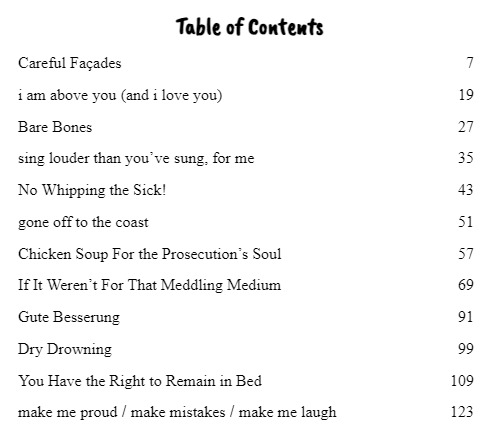
Like all things, you can play with fonts and margins.
Your book is READY TO GO. Save it as a PDF, you can do this by hitting the print button in docs and most other word processors. Then instead of choosing a printer hit ‘save as PDF.’ Scuttle on over to Lulu and make an account. Yes it is worth it. Fic!
Lulu is awesome because it has lots of customization options. If you wanna get fancy with it, you could insert images into your PDF and get a colour book! But I just order print books, basic black and white. Once you name and upload your PDF, you can choose EVERYTHING. What kind of paper you want. If you want hardcover or paperback. The world is your oyster. Lulu will then give you a template for your cover, fitted to the dimensions of your fic book based on page number and what options you choose. They technically have a guide that lays this all out for you, but I find it incredibly confusing, so here is the streamlined wendy version:

There are a lot of options for how to make this cover. You can use an image editor, like photoshop, or you can draw fanart, or you can simply go into MSpaint and add some shitty little text to a solid colour if you don’t feel like anything fancy. A lot of people also use canva, which has tons of templates and assets you can throw together. I use canva so much i actually paid for a pro subscription lmao fsdghfgh but I also use photoshop a good deal. I made DTE’s covers in photoshop:

And Down’s cover in canva:
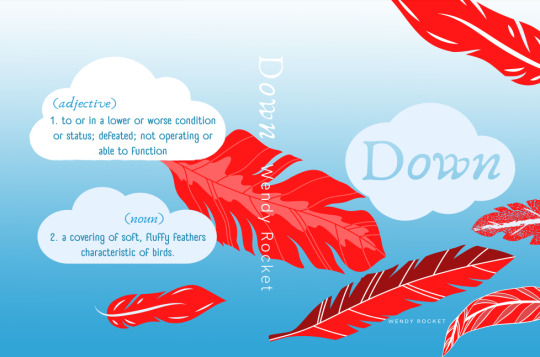
When I’m doing canva covers, I always just save the PDF, pop the template into photoshop, and then paste the images over it and rearrange them to my liking. I think Lulu also has an in-site canva editor but I don’t like learning new software. Photoshop is easy gfhfhg.
WHEN YOU ARE SAVING YOUR COVER. LISTEN TO ME. LISTEN THIS IS IMPORTANT ESP IF YOU NEVER TOOK GRAPHIC DESIGN OR HAVEN’T PROFESSIONALLY PRINTED ANYTHING. When you are saving your cover. SWITCH YOUR COLOUR PROFILE TO CMYK!!! Do not save it as RGB! RGB is good for digital graphics, but if you EVER print something you need to switch it to CMYK. I FORGOT TO DO THIS SOMEHOW when I printed my first two fic books, so their covers look a little washed out. When you do this in your photo editing software, they will look washed out there too–this is normal. They will print SO much better. Just trust me.
Make sure you save your cover as a PDF and pop it onto Lulu! It’ll show you a preview of your book and cover which you can go by page by page to look for mistakes or anything you may want to change. In this preview the cover will ALWAYS look like a shitty, jpeggy mess. IT DOES NOT LOOK LIKE THAT IRL. I was so concerned fghfg but they print fine the preview just sucks.
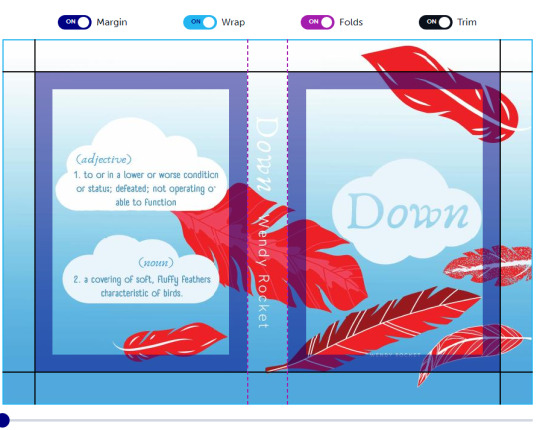
wow so cool. this is for Down's hardcover which has a lot of margin. the closest summation of what your book will be like is to turn everything here off but the folds:

so cool. thats my book.
And you’re good to go! Enjoy your fic!!! PHYSICAL FIC IN YOUR HANDS!!! I got to experience the most magical thing recently: my friend bought a copy of Down, and then SHIPPED IT TO MY HOUSE, and i got to SIGN IT. I got to SIGN a copy of a BOOK I WROTE. They loved it that much. And I had the PDFs. PDFs I need to update, because I didn’t know half the shit I just wrote here when I made them. BUT I GOT TO SIGN MY FIC!!! SOMEONE LIKED IT ENOUGH TO BUY IT, AND THEN SEND IT TO ME, TO SIGN!!!
All the money here goes to printing costs, if that wasn’t obv. Paperbacks on Lulu can be under ten bucks depending on how thick they are, and hardcovers are usually under 25. It’s insane to me how cheap it is to print fanfic, and once you try, you WILL be addicted.
I tried to make this tutorial easy to follow, i hope it was! If anyone has any questions about the process, I am always happy to answer. Or, um, if you just want me to do all this formatting FOR you… I might be open to doing it for free. Mutuals get first dibs but I genuinely LOVE formatting docs for printing. I can’t help you with covers (i flounder even making them for stories I love) but I’ll always format a fic or several fics for you. Just HMU ghfghgf
228 notes
·
View notes
Text
Shoujo Manga’s Golden Decade (Part 1)
Shoujo manga, comics for girls, played a pivotal role in shaping Japanese girls' culture, and its dynamic evolution mirrors the prevailing trends and aspirations of the era. For many, this genre peaked in the 1970s. But why?

Manga stands as one of Japan's primary cultural exports, deeply ingrained in the local culture and enjoyed by individuals of all ages and genders across various genres. Conventionally, manga is divided into two editorial segments: shonen (targeted at boys) and shoujo (targeted at girls). While shonen manga, propelled by hits like "Dragon Ball," "Slam Dunk," "Naruto," and "One Piece," has achieved global popularity, girls' comics, with their own international sensations such as "Sailor Moon," hold a crucial position in the market. The evolving landscape of girls' manga serves as a fascinating lens through which to observe the shifting fashionable aspirations and beauty ideals within Japanese society.
Shoujo manga has a rich history, dating back to the early 20th century. However, it truly gained recognition in its modern form in the late '50s and early '60s when prominent Japanese publishers introduced shoujo manga anthologies such as Kodansha's Nakayoshi and Shoujo Friend, as well as Shueisha's Ribon and Margaret. The acclaimed "godfather of manga," Osamu Tezuka, is often credited with creating the first modern shoujo, "The Princess Knight," in 1954, and the first shonen, "Astro Boy," in 1952.
A distinguishing feature of shoujo manga is that it is created by and for girls. But, in the '50s, this wasn't the case, and male artists dominated the shoujo field, which was considered an entryway to the manga business. By the 1960s, that would change as publishers recognized that women creators possessed a unique proficiency in crafting narratives centered around female experiences. Female manga-kas resonated with readers in a way that many male artists couldn't, marking a crucial shift in the landscape of shoujo manga.
The Volleyball Craze
A notable display of how shoujo could mirror societal trends unfolded in the '60s. In 1964, the Tokyo Olympics marked a new beginning for post-war Japan, and the female volleyball team, known as Toyo no Majou (the Oriental Witches), achieved stardom by clinching victory in the finals against the Soviet Republic. This triumph triggered a nationwide "volleyball boom," resonating particularly within the shoujo manga realm.
Shueisha's Ribon, historically the leader in the shoujo manga field, started publication in 1955. Still, the editorial house would only begin to make its series available in standalone tankobon format almost 15 years later through the now iconic Ribon Mascot Comics imprint. The first series to be made available by the imprint was Chikako Ide's "Viva Volleyball."
Simultaneously, over at Kodansha, Shoujo Friend was also eager to capitalize on the boom. Editors commissioned a title about the sport from illustrator Akira Mochizuki and novelist Shiro Jimbo. The final project, "Sign wa V," became a multimedia success, being quickly adapted into a live-action TV drama that achieved very high ratings.
While "Viva! Volleyball" and "Sign wa V" enjoyed success in their time, they did not etch themselves into the collective memory. The true shoujo sports manga blockbuster, a cross-generational classic universally known in Japan, is Chikako Urano's "Attack No. 1," serialized from 1968 to 1970 in Weekly Margaret.

It became the first shoujo manga title to surpass ten tankobon volumes (it had a total of 12 volumes), and it was forever immortalized thanks to its 1970 anime adaptation, which reached huge ratings on Japanese TV. Everything about "Attack No. 1" -- from the original manga to the cartoon adaptation to the anime's theme song, which sold over 700k copies as a single -- was a success.
The story of a high school girl trying to become the best player in her school, in Japan, and, eventually, in the world became a phenomenon setting the stage for the '70s "golden era of shoujo."
The Shoujo Lost Years
Until the '70s, manga carried the stigma of being a guilty pleasure, often viewed as a "poison" meant to dumb down young readers. Despite a few discerning individuals recognizing the medium's potential, manga critics, enthusiasts, and tastemakers — predominantly men — largely disregarded female-centric comics. Shoujo manga, despite its immense popularity, faced the harshest criticism.
Because society and critics downplayed shoujo, influential shoujo manga-kas from the '50s and '60s, such as Hideko Mizuno, do not enjoy the same level of recognition as their shonen counterparts from that era.

Hideko Mizuno and a page of one of her most celebrated works, "Fire."
Mizuno was one of the first women to create manga, worked as an assistant to Osamu Tezuka, and was behind several massive hits that had a significant impact on women in the '50s, '60s, and '70s. In fact, the most iconic shoujo manga-kas from the '70s golden period directly mention her as an influence. She fought to include romance -- now the essential element in girls' manga -- in her works back when such topics were deemed inappropriate by male editors.
Mizuno's repertoire was vast: she wrote mangas about little girls and their poneys, magic adventures, and romcoms based on Audrey Hepburn's movies, and she drew the first sex scene in a shoujo manga. The manga in question was "Fire," a teen-targeted manga featuring a rebellious American rocker, which broke new ground by having a male character as its focal point. Alongside other notable female artists from the '60s, Mizuno laid the groundwork for the '70s shoujo explosion, during which girls' comics took center stage.

In 1960's "Hoshi no Tategoto" (left,) Hideko Mizuno created the first shoujo love story. Serialized in Weekly Margaret between 1964 and 65, "Shiroi Troika," set during the Russian Revolution, was the first historical shoujo manga.
A contributing factor to this "golden period" was the emergence of several shoujo mangas as unstoppable hits, selling millions of copies and becoming cultural phenomena. These titles, considered masterpieces, continue to be read and known by multiple generations.
The BeruBara Boom
"Attack No. 1"'s success spread far and wide, forcing Japanese society to take note of the potential of the shoujo segment. Right after this historic success, Shueisha's Weekly Margaret hit the jackpot once again with another epoch-defining manga hit, Ryoko Ikeda's "The Rose of Versailles," which debuted in 1972. Set in the years preceding and during the French Revolution, it weaved together historical figures like Marie Antoinette and fictional ones, like the iconic Lady Oscar, a handsome noblewoman raised as a boy to succeed her father as the commander of the Royal Guard at the Palace of Versailles.

The first volume of the original comic had Marie Antoinette on the cover as Margaret's editors believed she'd be the favorite character. However, the androgynous Lady Oscar turned into a fan fave and the absolute star of the series, which is reflected on the cover of most rereleases since then, including the 2013 bunko version seen above.
When talking about shoujo manga classics from the '70s recognized by literally everyone in Japan, "Rose of Versailles" is probably the first name that comes to mind. It was a hit that really defined the era and impacted the country as a whole. While Marie Antoinette is seen around the world as a tragic, out-of-touch figure, in Japan, many women and girls see her as an aspirational historical fashion icon. While Sofia Coppola's 2006 film "Marie Antoinette" solidified this among younger generations, it was Ikeda's gentle portrait that made her a character loved by so many across all age groups.
When conceptualizing the story, Ikeda was heavily inspired by Stefan Zweig's "Marie Antoinette: The Portrait of an Average Woman," which she read while in high school. Once in college, in the late '60s, she, like millions of others, was heavily involved with the Marxist student movements. These references led to a historical romance that touched on heavy and revolutionary themes, which was atypical for a shoujo manga, a segment that, back then, was primarily catered to elementary school-aged girls.
Because of its unorthodox concept, Margaret's editors were unsure about the series. But right from the start, "BeruBara" (derived from the original Japanese title, "Berusaiyu no Bara"), serialized between 1972 and 1973, was an explosive hit, quickly turning into Weekly Margaret's most popular series. It was compiled in 10 tankobon volumes published, which sold tens of millions of copies.
In 1974, after the original manga had finished its serialization, Takarazuka Revue, an all-female theatrical troupe, announced a stage adaptation of the story.
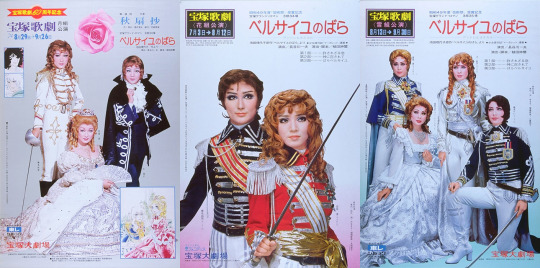
Posters of the first three Takarazuka adaptations, from between 1974 and 1975. Since then, the Revue has adapted the manga 11 times, with a new run scheduled for 2024.
The Revue was established in 1913 by the owner of Kansai's leading railway company, Hankyu, to boost tourism to the city of Takarazuka, his line's last stop. It was a huge success, and soon, the group had its own luxurious theater as well as its very exclusive academy where young ladies underwent an arduous audition process to become Takaraziennes. In 1934, a second Takarazuka theater opened in Tokyo.
However, in the early 1970s, Takarazuka faced stagnation, with declining ticket sales attributed to the growing popularity of alternative entertainment forms such as cinema and television.
In 1973, Shinji Ueda, who had risen through the Takarazuka ranks as a director, made his debut as a playwriter in the company with a musical based on ancient Japanese history. While thinking about his next project, he decided to check out a manga popular with some Takarazuka fans, "Rose of Versailles," and he quickly realized it was the perfect theme for an adaptation. Lady Oscar, who had lady-like features but was also as handsome as a man, was the embodiment of the male role-playing Takaraziennes. Ueda reached out to Ryoko Ikeda, who, as an admirer of the troupe, quickly granted the rights.
But Ikeda and Ueda's excitement wasn't shared by many. Most of the Takarazuka team were skeptical about a play inspired by something as vulgar as a manga. Fans of the original were also highly protective of its characters and entirely against a live adaptation.
Amid this climate of distrust, the play opened at the end of August 1974 at the Takarazuka Grand Theater. The reaction after the first night was extremely positive. Soon, Takarazuka's "Rose of Versailles" was the hottest ticket in all of Japan, with the press breathlessly covering the "BeruBara boom" that led thousands of people to stand hours in line to get tickets to the coveted performances in Kansai and Tokyo. Ikeda herself was shocked by the media phenomenon when she returned from an overseas trip and had hundreds of reporters awaiting her at the airport.

A statue of Lady Oscar and Andre surrounded by rose bushes sits outside the Takarazuka Grand Theater in Hyogo, Japan.
The "BeruBara" phenomenon single-handedly reversed Takarazuka's fortunes, leading to record-shattering ticket sales for the company. The Takarazuka Academy, which had seen declining applicants, suddenly became highly sought-after again, originating the saying "Todai in the East, Takarazuka in the West," comparing it to Tokyo University, the most prestigious university in Japan. The phrase underscored the desirability and prestige associated with a position at the troupe.
Ultimately, the success of "The Rose of Versailles" propelled Takarazuka back to the pinnacle of the entertainment industry, a position it maintains to this day. The brand continues to hold great esteem among women of all ages in Japan, with Takarazuka's stage adaptations, derived from Broadway musicals, movies, novels, and shoujo manga, consistently selling out. Notably, various adaptations of "BeruBara" have collectively sold over 5 million tickets since 1974.
Following the manga and Takarazuka adaptation's explosive success, the anime debuted in 1979. While the anime received acclaim, Ikeda herself was not entirely satisfied, mainly due to the treatment of her favorite character, Andre, who played a significant role in the manga but had a minor presence in the animated version, which focused almost entirely on the manga's most popular character, Lady Oscar.

In 2013, celebrating Margaret's 50th anniversary, new special chapters of "BeruBara" were published. The first new story in 40 years resulted in Margaret magazine selling out across the country.
"BeruBara" remains a prominent franchise in Japan, spawning numerous licensed products, sequels, and spin-offs. Ryoko Ikeda, known for other successful series, continues to garner widespread respect and media attention. However, while almost everything related to "The Rose of Versailles" turned into a hit, there was an exception.
In March 1979, a few months before the anime premiere, a live-action film adaptation debuted with great fanfare. Fittingly for such a hot property, the movie was one of the most ambitious productions in Japanese cinema, with a substantial 1 billion yen budget.
The Palace of Versailles granted permission to shoot in its interior. The film was filmed in English, with a European cast. The project was helmed by France's hottest movie director, Jacques Demy. Demy wasn't respected only in the West but also in Japan, where his two most important films, "The Umbrellas of Cherbourg" (1964) and "The Young Girls of Rochefort (1967)," were also hits. In fact, to this day, both flicks remain popular among trend-conscious Japanese as examples of stylish oshare movies that fully capture aspirational girls' culture (alongside, among others, Sofia Coppola's "Marie Antoinette"). Demy, the mind behind dreamy, girly movies, seemed like the perfect choice to turn this blockbuster shoujo classic into a live-action film.
The movie had the backing of three gigantic domestic corporations: Toho, the leading Japanese movie distributor; Nihon Terebi (NTV), one of the main TV stations; and cosmetic giant Shiseido. NTV and Shiseido made sure the movie had one of the most extensive marketing campaigns Japan had ever witnessed. The TV station aired specials and segments on this grand production. Meanwhile, Shiseido made the star of the movie -- British actress Catriona McCall, who played Oscar -- the face of its spring campaign, promoting its new Red Rose lipstick. Catriona was plastered on billboards across the country, made media and department store appearances, and starred in luxurious TV spots.

On the left, Lady Oscar and Marie Antoinette adorn the cover of Margaret in 2016, over 40 years after the end of the original serialization. On the right, Oscar models Dolce & Gabanna new collection for high-end fashion magazine Spur in 2014, celebrating 40 years of the conclusion of the original manga.
Back then, Kanebo, the second biggest local cosmetic company, was in fierce competition with Shiseido. TV ads from both companies had a tremendous impact, propelling singles to the top of the charts, and there was a battle on which commercial would feature the biggest hit. But, in the spring of 79, the focus of the fight changed. As a response to the Catriona "Rose of Versailles" campaign, Kanebo also hired a British beauty, actress Olivia Hussey, and launched a "Super Rose lipstick" with the tagline "You are more beautiful than a rose." The cosmetics war was another proof of the chokehold "The Rose of Versailles" had in the decade.
But, when the movie finally premiered, it was a flop. Critics hated it. Japanese fans thought the adaptation was weak and lacked impact. Catriona, in particular, was very criticized for not conveying Oscar's androgynous charm, which perfectly balanced masculinity and femininity. With the well-received anime premiering just a few months later, the expensive movie adaptation ended up being outshined and forgotten. It became only a costly footnote in its history.
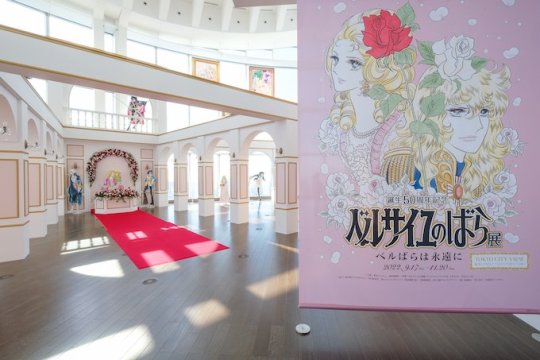
An exhibition in Tokyo celebrates 50 years of BeruBara in 2022.
(It's worth noting that Kanebo clearly won the CM war. The "You Are More Beautiful than a Rose" song they commissioned from singer Akira Fuse became a considerable hit).
Movie aside, "The Rose of Versailles" is one of Japan's most beloved comics. From its debut in 1971 to its film and anime adaptation in 1979, it remained front and center in the country's mind throughout the whole decade. Its impact was felt in different fields, from the cosmetic business to the publishing business, from live theater to TV. It also forever changed how shoujo manga was perceived and remains one of the country's most beloved properties.
Ace-Scoring Manga
The 1970s marked a turning point for shoujo manga, as it began to gain recognition beyond its traditional audience, propelled not just by critical acclaim but by commercial success. The era witnessed the emergence of several blockbusters that captured the public's imagination. Notable among them were Yoko Shoji's "Seito Shokun," a tale centered on the daily exploits of a mischievous high-schooler, and Waki Yamato's "Haikara-san ga Toru," a love story set in the Meiji period featuring a tomboy with a lady-like demeanor. These manga were significant hits during their publication in Shoujo Friends, becoming best-selling titles.
Some shoujo classics from the '70s are still in publication today, appealing to a diverse readership spanning multiple generations. Suzue Michi's "Glass Mask," serialized in Hana to Yume since 1976, remains a cultural phenomenon with 49 tankobon volumes, over 55 million copies sold, an anime adaptation, a live-action drama, and a stage play. Similarly, Chieko Hosokawa's "Crest of the Royal Family," chronicling the adventures of a young American girl transported to ancient Egypt, has been a consistent presence in Princess magazine since 1976, boasting 69 volumes and over 45 million copies sold to date.
But, when talking about definitive shoujo classics from the '70s, titles that were historical successes, influenced everything going forward, and are known by everyone, three titles come to mind. We already explored one of these, "The Rose of Versailles." One of the other three is "Ace wo Nerae."

Following the monumental success of "Attack No. 1," the prospects of another shoujo sports manga achieving similar heights of popularity seemed improbable. However, Weekly Margaret defied expectations once more in 1973 with the release of Suzumika Yamamoto's "Ace wo Nerae" ("Aim for the Ace"), a compelling narrative focused on tennis that swiftly captured the nation's attention.
Japan and tennis already had some prior history. The first Japanese Olympic medalist was a tennis player, Ichy Kumagae, in 1920. Emperor Akihito met his commoner wife, Michiko, at a tennis match, and they initially bonded over their love for the sport. But, in the 70s, the country was taken over by an unprecedented tennis boom. At high schools across the nation, tennis became the most popular after-school activity. Fashion magazines like JJ and Popeye dedicated pages and pages to "tennis fashion." At the same time, trendy young adults decked in clothes from sports brands populated Shibuya and other stylish districts in Tokyo.
There were several contributors to the tennis boom. But the remarkable success of "Ace wo Nerae," which first conquered girls before dominating the nation, played a part in it.
The manga follows the journey of Hiromi Oka, a high school student initially plagued by insecurities but propelled into the world of tennis through the encouragement of her coach. "Ace wo Nerae" portrays her growth from a hesitant newcomer to a world-class tennis player, navigating challenges and discovering hidden potential along the way.

From left to right: Madame Butterfly, lead character Hiromi Oka and coach Jin Murakata as depicted in the anime. Madame Butterfly, a rich wealthy student who was gentle and a world-class tennis player, is a fan favorite character.
In 1973, "Ace wo Nerae" was adapted into an anime. Despite initial modest ratings, the anime gained popularity through reruns. Encouraged by this, NTV decided to remake the cartoon. The second adaptation, which debuted in 1978, was an immediate hit. Concurrently, Weekly Margaret revived the manga series, which, after being first finalized in 1975, ran again from 1978 to 1980, spanning a total of 18 volumes.
Since "Ace wo Nerae," several hit mangas focused on tennis -- both shoujo and shonen -- were published. But, thanks to the success of its anime and the intragenerational support for the manga, the original work by Suzumika Yamamoto is still considered one of the defining and most beloved works about the sport. Its role in propelling tennis culture as part of the oshare youth culture of the '70s also defines its impact.
Japan Wants Candy
Following the monumental multimedia success of "The Rose of Versailles" and "Ace wo Nerae," the third shoujo sensation of the '70s is "Candy Candy."

Initially published in Nakayoshi, the story started taking shape when editors at the magazine sought a work of literary excellence akin to beloved classics popular among girls, like "Heidi" and "Anne of Green Gables." They enlisted Keiko Nagita, writing under the pen name Kyoko Mizuki, and paired her with one of the magazine's most famous artists, Yumiko Igarashi. The collaborative effort resulted in the creation of "Candy Candy," centered around an American, blond, blue-eyed orphan named Candice "Candy" White Ardlay.
"Candy Candy" epitomized various shoujo directions prevalent in the '70s. The protagonist, a white girl with lustrous blonde hair, embodied the fascination with Western culture during a time when Japanese youth held a keen interest in Europe and the United States. The manga's narrative style, characterized by its dramatic tone and intricate plot twists, also aligned with the prevalent storytelling preferences of the era.
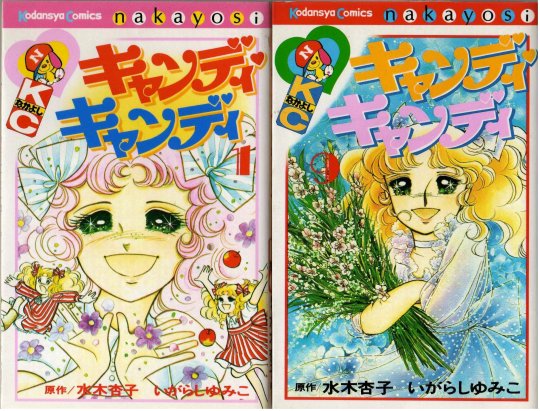
Candy Candy was such a resounding success that it became the first manga to achieve an initial print run of over 1 million copies of one of its paperback compilations.
Debuting in 1975, "Candy Candy" swiftly captured the hearts of Nakayoshi's readers, leading to unprecedented success. The subsequent anime adaptation by Toei in the following year propelled the franchise into the realm of a cultural phenomenon, sending manga tankobon sales skyrocketing. The seventh volume of the "Candy Candy" compiled paperback reportedly became the first Japanese manga to achieve an initial print run of over 1 million copies. Additionally, Nakayoshi's sales surged, surpassing those of Shueisha's Ribon for the first (and only) time.
The adventures of young Candy were also licensing gold. With over 100 licensed products, the "Candy Candy" doll alone sold 2 million units, solidifying Bandai's position as Japan's premier toymaker, a status it continues to uphold to this day. The resounding success of "Candy Candy" forged a lasting alliance between Kodansha's Nakayoshi, Toei Animation, and toymaker Bandai, which led to the iconic "Sailor Moon" franchise in the 1990s.
While "Candy Candy" concluded its run in 1979, its appeal extended far beyond its original target demographic, captivating kids, teenagers, and adults alike, thus contributing significantly to the manga and anime's widespread acclaim and enduring popularity.
However, a protracted legal dispute between Igarashi and Nagita has prevented the commercialization of any "Candy Candy" related products since the late 1990s, including reprints of the manga and re-broadcasting of the anime. The lawsuit arose from Igarashi's unauthorized licensing of merchandise based on the franchise, falsely asserting sole ownership of the copyright. Although Igarashi was initially credited as the lead artist in Nakayoshi during the manga's publication, the court ultimately ruled in Nagita's favor, emphasizing that Igarashi's artistic foundation was built upon Nagita's written work.
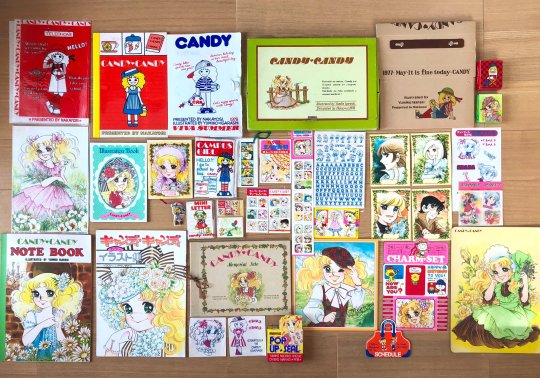
A collection of "Candy Candy" freebies offered by Nakayoshi magazine in the '70s. During the publication of the series, Nakayoshi would eclipse Ribon's sales for the one and only time in its history, (image credit)
Consequently, any commercial exploitation of Yumiko Igarashi's "Candy Candy" artwork necessitates the approval of both Igarashi and Nagita, a challenging prospect given the existing feud. Nagita, on the other hand, can profit from "Candy Candy" as long as she doesn't include any illustrations, which allowed her to release a book sequel in 2010. However, due to the dispute, one of the most beloved works in Japanese manga history is currently out of print. The lawsuit also blocks the anime from being aired or distributed. But, despite the almost two-decades-long media ban, "Candy Candy" remains widely known and beloved across Japan, a testament to its staying power.
While smash hits like "Candy Candy," "Ace wo Nerae," "Rose of Versailles," "Seito Shokun," "Hikara-san ga Tooru," and "Glass Mask," among others were key pieces into shoujo finally earning the respect it deserved, the rise of a revolutionary group of artists during the '70s was another critical element in shoujo's rise: the Year of 24 Group.
Part 2
#1970s japan#1970s#vintage shoujo#shoujo manga#lady oscar#rose of versailles#ace wo nerae#candy candy
43 notes
·
View notes
Text
Tezucomi magazine receives a 2 volume release in North America in 2024; will only include manga from European artists
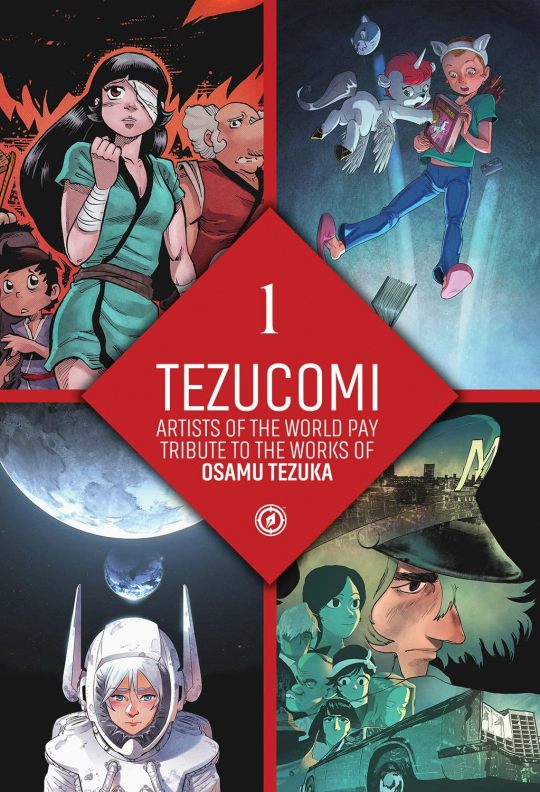

Sources: Amazon (Volume 1, Volume 2), Kickstarter
Tezucomi manga magazine will receive a 2 volume North American release through Magnetic Press; it will only include the European manga that were included in the original release from Japan.
Tezucomi Volume 1 is set to release on February 13, 2024, while Volume 2 will release on March 12, 2024.
These releases came about from a successful Kickstarter from Neurobellum Productions!
Tezucomi was an Osamu Tezuka anthology magazine containing manga drawn from comic/manga artists around the world. It began in 2018 and ran for 18 volumes.
A summary of both volumes as posted on Amazon's website:
Volume 1:
An anthology of short stories based on some of the many popular creations of legendary Japanese mangaka Osamu Tezuka, as illustrated by a collection of some of the greatest comic creators in Europe. This larger 300-page hardcover edition is presented in traditional manga reading order, right to left.
This first volume includes "The Mouse" by Sourya, based on AYAKO; "The Moon Rabbit" by Brice Cossu and Valerie Mangin, based on BUDDHA; "A Taste for Blood" by Philippe Cardona and Florence Torta, based on DORORO; "The Cursed" by Mathieu Bablet, based on METROPOLIS; "The Eyes of Pandora" by Victor Santos, based on MW; "Love at First Sight" by JD Moravn and ScieTronc, based on MIDNIGHT; "Doppelganger" by Belen Ortega and Victor Santos, based on BARBARA; "The Parchment of the Cat" by Kenny Ruiz, based on MY SONGOKU; and "Catalante" by Mig, based on UNICO.
Volume 2:
An anthology of short stories based on some of the many popular creations of legendary Japanese mangaka Osamu Tezuka, as illustrated by a collection of some of the greatest comic creators in Europe. This larger 300-page hardcover edition is presented in traditional manga reading order, right to left.
This second volume includes "Big X" by David Lafuente, based on BIG X; "The Creator and the Destroyer" by Philippe Cardona and Florence Torta, based on ASTRO BOY; "The Last Recital" by Bertrand Gatignol, based on BLACK JACK; "The 3 Richards" by Juan Diaz Canales, based on MESSAGE TO ADOLF; "The Guardian of Mount Moon" by Reno Lemaire, based on KIMBA THE WHITE LION; "Mina's Song" by Luis NCT, based on APOLLO'S SONG; "Heartless" by Joe Kelly and Ken Niimura, based on BLACK JACK; "Princess Knight" by Elsa Brants, based on PRINCESS KNIGHT; and "Team Phoenix" by Kenny Ruiz with Studio Kosen, based on several works of Osamu Tezuka.
22 notes
·
View notes
Text
2022 in books
inspired by everybody else who is also doing 2022 bookbinding end-of-year reviews, here we go!
I made a total of 38 books, containing 52 stories.
A5 sized books
The Astreiant series by Melissa Scott and Lisa A. Barnett, 5 books and 6 stories. Point of Knives includes Bonfire Night, a short story Melissa posted to her LJ about how Nico and Philip really got together after the events of Point of Hopes.

Astreiant series

besides the Astreiant series, I also bound a copy of Slow Dancing In A Burning Room (one of my fave 00Q fics), mm whatcha say (Sarkan/Solya, Uprooted) and Indiana Lupin (the first volume in my R/S fics series). All four are different types of bindings! Astreiant is squareback bradel, Slow Dancing is rounded and backed bradel, mm watcha say is a sewn board binding, and Indiana Lupin is a plain old hardback binding, but self-ended.
Slow Dancing in a Burning Room | Slow Dancing In a Burning Room | mm watcha say
A6 sized books
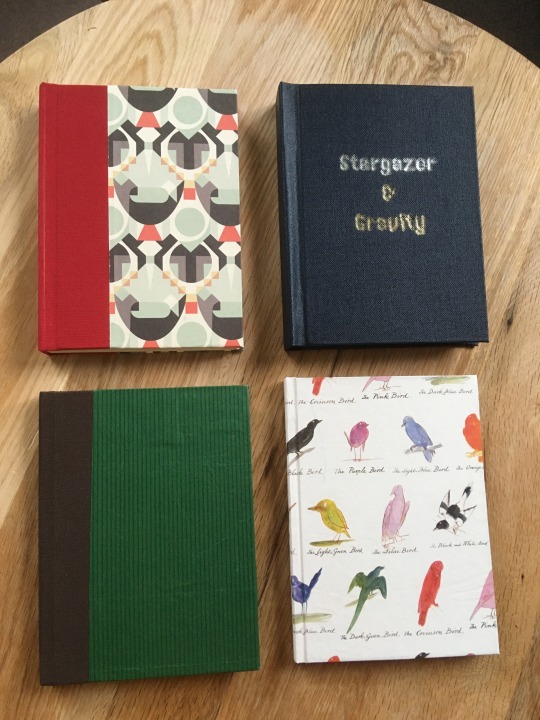
from left to right: vol2 in the R/S fics series; Stargazer and Gravity (Fahye); golden hours, slipping by and oceans above & sky below (grandilloquism); Two Make A Pair and Come When Invited (mousapelli).
I collected all of my Remus/Sirius fics into a 6 volume series, one story per volume with the exception of vol3, which is an anthology of my shorter fics and contains a total of 12 stories. I'm really happy with how well matched the books are and how bright and inviting they look!
The other three A6 hardbacks pictured all contain 2 stories each. Stargazer & Gravity has one after the other as Gravity is a sequel, but the other two books are tête-bêche bindings, meaning that the stories are bound in head to tail and when you flip the book over you can start reading the other story from the other direction. And yes, Come When Invited *is* a sequel to Two Make A Pair and I had intended for them to be bound in two different volumes, but then at the last minute I sewed the two blocks together and oops now it's a tête-bêche book.
R/S fics series | Stargazer and Gravity | golden hours, slipping by and oceans above & sky below | Two Make A Pair & Come When Invited

paperbacks! Hood & Glove (Fahye) on the right is the first paperback I made - an experiment really, I made a text block like for HB and then pasted the first and last page down to the cover, like a self-ended HB. the other two are made in the same way, but the cover is cut from a misprinted running sheet, cardstock, that came wrapped around some decorative paper as protective wrapping. I don't like to waste materials and the misprints were so intriguing and beautiful I just had to use them. These two are Destiel fics, There's Only One Sure Thing That I Know (probably the one SPN fic I reread most often) and The Mostly Accidental Courtship of Dean Winchester.
Hood & Glove | 2 x destiel PBs

NO GLUE PAMPHLETS MY BELOVED. listen, there's a lot of glue in bookbinding and sometimes I just get REALLY SICK OF IT and making these pamphlets was like a balm for the soul. as evidenced I remade Dozens of Ships because I wasn't entirely happy with how the first one came out (and also, the first one lived in my purse for so long it's now all tatty. I took it with me on vacation to Oxford so I could just read it whenever I wanted. it was amazing.) Project Bang doesn't have a cover because I wanted to try French link stitching, but I think I will take out the thread sometime and give it a cover and re-sew it like the other three.
Dozens of Ships and Hundreds of Souls | Izzy's Revenge | Project Bang
A7 sized books

1 hardback, 1 no-glue pamphlet, and 8 paperbacks.
the hardback (the birth of comets takes place on the tip of your lashes) is my first attempt at self-ending a HB and I did it because the book was so small I thought structurally it wouldn't be an issue, and it worked so well I did it again for a bunch of books. the pamphlet I made to see if no-glue pamphlet were comfortable on a smaller scale, and while it was fine I think this one I will also take the the thread out eventually and sew a cover on.
and then more paperbacks! fanbinding seems to favour longer fics in general because having a substantial amount of text means you have enough material to comfortably make an A5 or A6 sized hardback. however I like a lot of short fics too and while I like the idea of anthologies, sometimes I also just want little books to carry in my purse and read on the go, you know? and I've found these A7 paperbacks to be perfect for fics in the 1-5k word count weight class. and since I have an entire running sheet to make covers from, I'm not done making A7 paperbacks either!
the birth of comets | 4 x Ocean's 8 fics | 4 x 00Q fics
Gift books
and finally... the three Renegade Exchange Books I made during the October-December radio silence period:

2 x squareback hardbacks and 1 rounded hardback.
Something Dumb to Do | Inside The River | Sha Ka Ree
That's all folks!
153 notes
·
View notes
Text
Time is Running Out to Back Our KS Campaign!
Want to help fans make their publishing dreams come true?
Want 20 amazing stories and 19 awesome art pieces AND a 12-page comic, all super-duper LGBTQIA+, all made by fan authors and artists, all inspired by The Three Musketeers?
Want an anthology that feels like a fandom zine, except the fanworks are completely legal?
Want to support a queer-owned indie publisher run by fandom's own @unforth?
THEN HAVE WE HERE AT DUCK PRINTS PRESS GOT AN ANTHOLOGY FOR YOU!
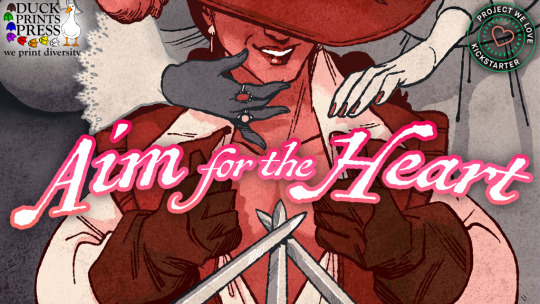
The Kickstarter campaign to back Aim For The Heart: Queer Fanworks Inspired by Alexandre Dumas's "The Three Musketeers" ends on Saturday, July 15th, at 10:15 AM Eastern Time - as of the time I'm posting this, there's only 48 hours left to back!
For this collection, we recruited 20 authors and 16 artists who love Athos, Porthos, Aramis, d'Artagnan, Milady, Madame Bonacieux, and the whole gang from Dumas's wonderful historical melodrama. These creators' mission was simple: take this long-adored story and make it queer! The result is an amazing collection of works exploring the nuances of these characters, delving into issues of identity, gender, and sexuality—telling and retelling a story we all know and love.
We've got a great book! We've got gorgeous merch! So come on over and check out our campaign, and get your book on!
#kickstarter#aim for the heart#queer anthology#queer fiction#queer art#the three musketeers#zine#zines#queer zine#fandom zine#three musketeers#3 musketeers#projects we love#projectswelove#kickstarter campaign#queer kickstarter#lgbtqia anthology#lgbtqia fiction#lgbtqia art
219 notes
·
View notes
Text
Fanfic Writer Questions
Tagged by @melisusthewee, and at least another person. I'm sorry if I ignored the tag, I was away and it's a busy period, let me know ;_;
Tagging forward: @ndostairlyrium @shivunin @inquisimer and YOU who are reading and would like to do it!
1. How many works do you have on AO3?
12, right now.
2. What's your total AO3 word count?
497,183
... I'm chatty.
3. What fandoms do you write for?
Dragon Age, and a crossover with LOTR/The Silmarillion.
4. What are your top 5 fics by kudos?
Home Was Never on the Ground (long fic, concluded, it's anthological and mainly me filling blanks in DAI as inspiration stroke)
She of Many Names (ongoing, a LOTR/Dragon Age crossover. A follower on Instagram asked me if Aisling was Sauron, the idea made me laugh so much that my mind took fire.)
Saturday Prompts (a collection of prompts I posted here. I never uploaded every one of them, oops)
Death and All of Its Friends (ongoing, a DA2 collection)
The Night Before First Day (Two chapters, concluded. One it's in rhyme and illustrated. Aisling taught her daughter that the Dreadwolf is Santa out of spite. Solas tries to disapprove.)
5. Do you respond to comments?
Yes, always!
6. What is the fic you wrote with the angstiest ending?
I do love angst, but I don't like angsty endings all that much ahahahahah.
I think the one that gets closer, in a bitter-sweet way, is One for the Road. Call me a sucker for rare-pairs, this was also prompted here and my brain took fire (LavellanxFenris)
7. What's the fic you wrote with the happiest ending?
The Night Before First Day.
Listen I'm not a Christmas person, I turn into a seasonal depressed Grinch at Christmas, living in a catholic country doesn't help, and that is my way of giving myself some joy.
8. Do you get hate on fics?
Not that I know of.
9. Do you write smut? If so, what kind?
Not any that I publish.
10. Do you write crossovers? What's the craziest one you've written?
Yes I do. She of Many Names is a Dragon Age and LOTR crossover.
I love it dearly, I'm slow to update it because I have the greatest love for Tolkien (with all his flaws, but my brain rewired when I saw the first movie, and the book has been my entire personality for two years. I wouldn't be the same person without it) and I do care of rendering it as I want.
11. Have you ever had a fic stolen?
... Not that I know of? I hope not, ahahahah :"D
12. Have you ever had a fic translated?
If you consider that English is not my first language, all my fics are translated? xD
Other than that, no.
13. Have you ever co-written a fic before?
No, but I'd love to.
14. What's your all time favorite ship?
EowynxFaramir, hands down. Out of pure lenght.
Maybe LeiaxHan Solo (my parents are both nerds, I think my mom made me watch Star Wars the first time... I don't remember, the vhs were always around in the house. I was very, very little.)(we don't talk about the sequel trilogy.)
15. What's a WIP you want to finish but doubt you ever will?
I tried to write a third chapter for the aforementioned One for the Road... But it ends up in a love triangle and I don't like love triangles that aren't a poly relationship. So, it's sitting in my folder and I'll never finish it. I was considering ditching the second chapter and rewrite it as a "Aisling as a companion in DA2" fic... But MEH.
16. What are your writing strengths?
I think dialogue. I am trained as a comic artist, which means that the writing parts that get polished are dialogue. I have much more experience with that.
... I am also terrible at judging my own work in a positive way, tho, so you tell me.
17. What are your writing weaknesses?
English not being my first language and leading to mis-spellings.
Other than that... I started writing fanfiction after YEARS of not writing anything in prose that wasn't screenplays for comics (which follows different rules). Since I stopped because of being hurt by it, I went on to it by not planning stuff.
I'm rusty with prose, and my retelling -the first thing I tackled- clearly had little planning ahead.
18. Thoughts on writing dialogue in another language in fic?
It's a no, for me, unless you specifically wants your audience not to understand what's being said and create a sense of isolation and of not knowing what's going on.
A sentence here and there with a translation is fine.
But if it's something long... You want the reader to understand well. Italicized text it is.
19. First fandom you wrote for?
I wouldn't call it a fandom, but: Greek Mythology.
I drew a parody comic of the Iliad in my first high school year, alongside friends. It had been so fun.
I also wrote, still in high school, something heavily inspired by Eragon, which only my friends had the pleasure of reading. (I'm only saying it involved my now most hated trope: THE SECRET TWIN.)
20. Favorite fic you've written?
The next one.
I'm very invested in Ashes and Sparks, aka the Dreadwolf AU.
I'm putting ideas in it and going fully canon divergent and writing it as I would like Inquisition to have gone. No Corypheus, more crazy tevinters, and the focus ON FUCKING TIME TRAVEL.
In a modern setting because yes.
It's also tackling something I absolutely hate in fiction when it's done wrongly, which is time travel, and I'm sweating and hoping I'll do it with logic.
It's something niche and not so focused on a single ship, so probably it'll interest only me, but I'm happily writing and trying to contain myself from posting chapters of more than 10k.
Blank Form Under the Cut
1. How many works do you have on AO3?
2. What's your total AO3 word count?
3. What fandoms do you write for?
4. What are your top 5 fics by kudos?
5. Do you respond to comments?
6. What is the fic you wrote with the angstiest ending?
7. What's the fic you wrote with the happiest ending?
8. Do you get hate on fics?
9. Do you write smut? If so, what kind?
10. Do you write crossovers? What's the craziest one you've written?
11. Have you ever had a fic stolen?
12. Have you ever had a fic translated?
13. Have you ever co-written a fic before?
14. What's your all time favorite ship?
15. What's a WIP you want to finish but doubt you ever will?
16. What are your writing strengths?
17. What are your writing weaknesses?
18. Thoughts on writing dialogue in another language in fic?
19. First fandom you wrote for?
20. Favorite fic you've written?
#fanfic writer questions#tagged petrel#fanfiction#ao3#writing petrel#mel you're rude to force me to say nice things about myself#buuuuuuh! *gives biscuits*
17 notes
·
View notes